The 11 Best HRIS Systems (2024)
Our HR tech experts demoed dozens of HRIS systems and researched many more to find the best tools on the market. Find pricing info, screenshots, pros & cons, and more below.
.png)
.png)
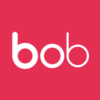









Human Resources Information Software (HRIS) is critical to business operations, but they tend to be fairly expensive with rigid contracts, and choosing the wrong one can be an operational disaster (not to mention bad for your reputation around the office).
The job of an HRIS is to be the unified system to handle all people processes. This includes TA/recruiting, compensation, leave management, organizational management, and sometimes more.
This guide covers everything you need to know to make a highly-informed choice if you’re in the market. We discuss cost, contracts, common pitfalls, ROI, and tips for product demos.
We will also bring in the voices of three expert contributors: Phil Strazzulla (our founder and CEO), Stacey Richey (VP of People at Corvus Insurance, 18+ years in HR) and Danielle Jones (CEO of Pinnacle Consulting Services, 10+ years in business and HR).
Best HRIS Systems
To choose the best HRIS, we meet with vendors for product demos and ask tough questions based on user research statistics, expert feedback from HR thought leaders and the real-world expertise of our editorial team.
The crucial features on which we evaluate HRIS systems include scalability, integration, self-service functionality, compliance and security, and total cost.
Scalability: We test each HRIS system’s capacity to handle rapidly growing teams by looking for features such as single sign-on, enterprise system integration, batch processes, and automations.
Integration Capabilities: Integration is critical for an HRIS. Each of our top picks integrates with existing systems such as payroll, talent management, or recruitment software to ensure seamless data sharing.
Reporting and Analytics: The best HRIS systems feature robust reporting and analytics capabilities and provide actionable insights into employee data, HR metrics such as employee growth and retention, and workforce trends such as the number of female executives.
Employee Self-Service: Each HRIS is evaluated by our experts for the quality of their self-service functionality. These critical features empower employees to access and update their own information, request time off, view pay stubs, and participate in performance management processes.
Information Security: It is crucial that HRIS vendors undergo regular audits such as SOC2. In addition to ensuring measures were in place to protect sensitive employee data, we also evaluated each platform’s approach to compliance with relevant employment laws and data protection regulations.
Total Cost of Ownership: It is important to know the overall cost of implementing and maintaining an HRIS system, including licensing fees, customization, training, and ongoing support costs.
To gain deeper insights into how we build these lists, check out this article about how we evaluate HR tech vendors.

Need Help? Talk to an HR Software Advisor!
Tell us more about your company & an HR Software Advisor will help you find the right software
.png)
Deel
.png)
Deel is a fantastic (did we mention free?) HRIS for remote and international teams that need a way to compensate their employees, and a system for record.
PROS
- Their HRIS is literally free
- You can pay employees and contractors globally through one system
- Employee experience features such as 1:1's and pulse surveys
- One of the best features of Deel is its customer service. They offer 24/7 in-app support and the fastest-in-class onboarding speed of 2-3 days. Users get access to local payroll experts in each jurisdiction, and support is available for contractors facing challenges setting themselves up as an LLC.
- Integrates seamlessly with common platforms like Quickbooks, Bamboo, Greenhouse, and more. They also offer custom integrations to automate and sync processes.
- Self-service approach; tech-enabled features so customers can jump in quickly and easily. Our user researchers found it quite easy to set up: the identity verification process consistently took less than 24 hours, and in some cases, it took mere minutes.
- Automated invoices, which are a breeze to do as long as they’re in English, both on the company and the contractor or employee’s side.
CONS
- This system can be expensive if you are a small remote team and using it to pay international employees (for example if you're a 10 person team with colleagues in 10 different countries, it will be close to $50k/yr, but this is the cost of paying people compliantly)
- Their HR suite is new, and therefore lacks a lot of features that you would expect in a Bamboo, Bob or other solution that's been on the market for years
- Some of Deel’s best and most powerful services, like onboarding automation, appear to be add-ons, which might be too costly for some companies
- There is little to no flexibility when it comes to altering their contracts or service agreements, so many changes would require an addendum.
- There is a $5 fee per payout
- As far as we’ve seen, it’s not possible to generate invoices in another language.
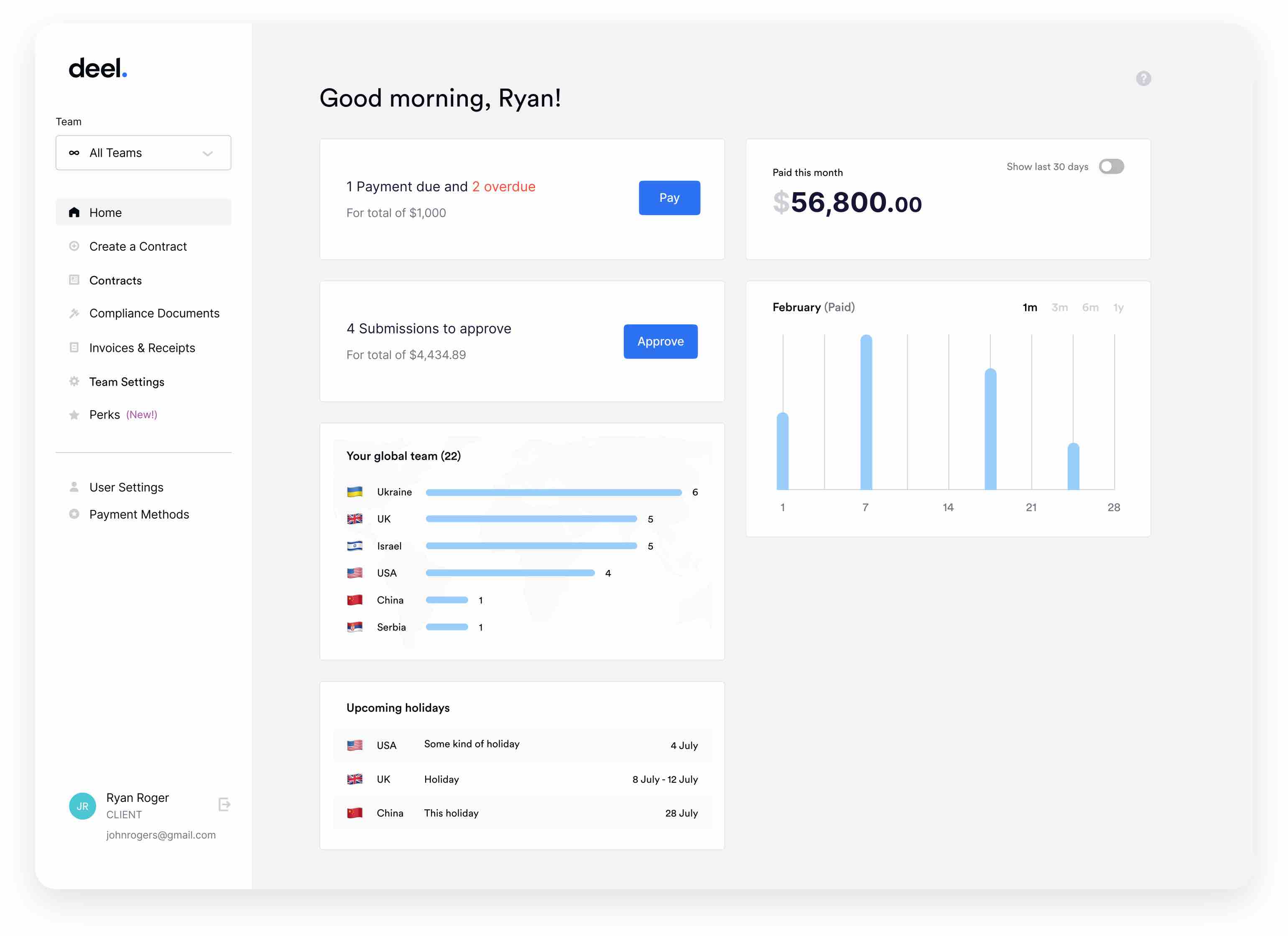
We added Deel's HRIS to this page as it's really the first free HRIS with a global focus. Deel has a number of very large companies (Nike, DropBox, Shopify) using their global payroll platform. However, we view this HRIS as more focused on SMB and mid market companies that need a solution for a global team. This is different than their global payroll solution which companies of all sizes can leverage.
Deel is a leader in the global payroll space, and this new HRIS functionality allows them to go deeper into the HR Tech stack of smaller companies. It's an easy, free, and adequate solution. That said, it reminds us of Gusto a bit in that the functionality isn't as robust as many HRIS's. Just like Gusto added some HRIS like features to their payroll offering, Deel is doing the same.
So - this is great for companies that are global, smaller, cost conscious. But, there will be tradeoffs with more robust systems (which of course will cost a lot more!).
- Brex
- Doogle
- Duffel
- Andela
- HomeLight
- Makerpad
Pricing for Deel's HRIS is completely free! However, they do make money as a business, mostly on their global payroll offering:
- Contractors: At $49 per contractor per month, Deel takes care of payroll and compliance for contracts in 150 countries.
- Full-time: From $500, this plan lets you hire full-time employees in a new country without having to set up a legal entity there. Deel becomes an Employer of Record and hires the employee for you.
Best For
Their HRIS is best for smaller companies that have global payroll needs.
Deel was used on a daily basis for us. It was used to manage all of our international contractors, manage contracts, payments, and payroll, and we used their employer-of-record model to hire in certain areas as well. Being able to run international payroll for various countries outside of the US using one system was extremely helpful. The customer support for Deel is also great, as you get an employment advisor as well who will help you understand how to best use Deel's international PEO/Employer-of-Record services. To summarize, hiring, international payroll, understanding employment/payroll laws of various countries, and making it digestible are the highlights of using Deel. It saved us a lot of time, money, and energy.
- I like that you can use one platform to run multiple payrolls for different countries.
- I like that they make hiring contractors in other countries easier.
- I like that they make understanding other countries' payroll and employment laws easy with all sorts of helpful resources.
Our small start-up company of under 50 employees was looking to hire international consultants in various areas, mainly Canada, Brazil, and later Poland and Ireland. We've used Deel for about 2 years now mainly for contract management and international payroll, and used their PEO and Employer of Record services as well. The key benefit is being able to hire great talent outside of the US and being protected and advised around payroll and employment laws for various countries.
- I dislike their reporting function as it's essentially just Excel and doesn't allow for advanced filtering/reporting.
- I dislike that the integration with Rippling is a bit wonky. Some employee info will flow in, but not all.
- I dislike that making changes in contracts can be difficult and that the e-signature capability is not great.
I believe that Deel is the best in class in terms of international hiring/payroll/compliance/PEO. They have a great team behind getting the system of hiring set up in each individual country. Their customer service is really great and they are great consultants that help you meet your goals. If you use their PEO or Employer of Record service it can be costly depending on where you're hiring.
- Location of Hiring - Depending on where you're hiring, Deel may not support that region so it's important to take a look at which areas they cover. They do cover most major areas of international hiring.
- Cost - Overall it's an affordable and effective system for international payroll. It does sit outside of the HRIS ( if you use one) so that's something to think about as an additional cost.
- HRIS Compatibility - It's also important to think about the compatibility with your HRIS, otherwise you have a lot of data sitting outside of your HRIS which you can manually upload through CSV reports.
In the time that I used Deel, they developed their PEO availability regions. I believe they do a good job at customer listening, and their team is extremely attentive.
Deel is great for small to medium-sized businesses that are looking to quickly expand internationally. It's also important to note that in each new location you're hiring in, if you're looking to have a hiring hub of 20+ more employees in that particular company, using Deel may only be a short-term solution. But for quick hires, small hiring hubs, and hiring consultants across countries, it's a great platform.
I imagine it may not be the best for a very well-established company with a significant number of hires in particular locations. For example, having 20+ employees in one country would not be the best fit for Deel.
BambooHR
BambooHR has been one of the go-to HR software for SMBs for years: It comes with stellar customer support, is easy to use, and gives companies some flexibility in purchasing the modules they want.
PROS
- Flexible packaging means you can pick out one or two packages and have other modules included as add-ons based on your needs.
- Straightforward platform that’s easy to navigate and customize.
- All plans/packages have custom pricing that most users think is reasonable.
- Integrates with some LMSs.
- Smooth onboarding workflow with many automation features.
- Has free trials.
- Flexible packaging and custom pricing is the way they roll. You can pick out one or two packages and pick other modules as add-ons based on your needs.
- Very simple and straightforward tool, easy to use.
CONS
- Payroll functionality is only available for US-based workers.
- Some popular integrations, such as QuickBooks, are missing from the platform.
- Customer support is excellent, but it is only accessible during business hours in U.S. time zones
- Desirable features like time monitoring, performance evaluation, and employee surveys can only be accessed as add-ons.
- According to some user reports, nothing prevents employees from scheduling vacation in excess of their allotted time
- Payroll is only available for US-based employees
- Customer support is only offered during US business hours.
- Some modules like time tracking, performance management, and surveys are only available as add-ons.
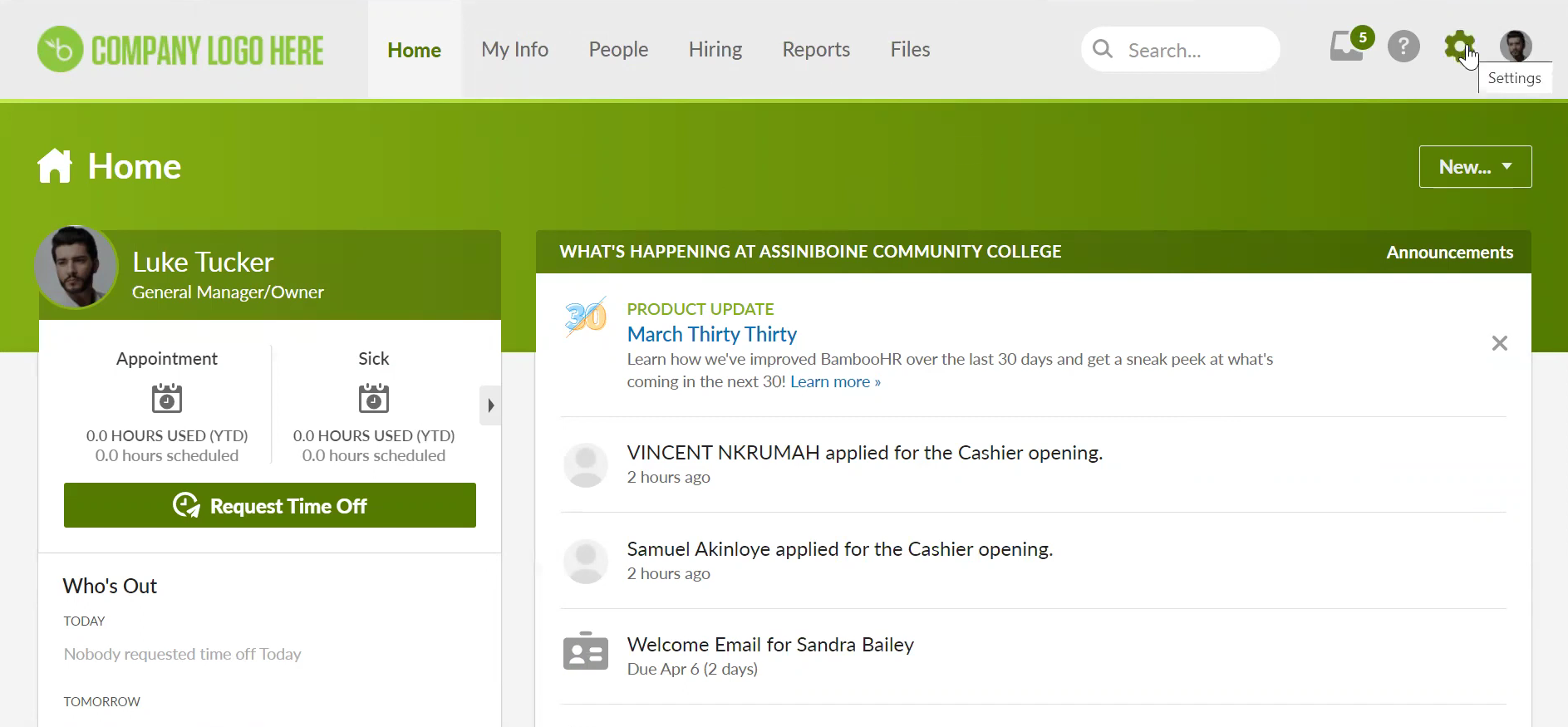
BambooHR’s platform has consistently been among the top choices for HR professionals in the US and beyond for over ten years. We gather this has to do with the fact that BambooHR spans the entire employee lifecycle. Aside from the Core HR functions like ATS, leave management, employee records, and a company calendar, they also have recruiting and performance management, and payroll available as add-ons. That said, the HRIS is offered as a small business package.
On top of their platform, BambooHR also has an app marketplace with integration options for dozens of HR/recruiting tools, as well as an HR glossary. They also host HR events from time to time.
Among the 20,000+ companies that use BambooHR, you’d find names like Quora, Universal Group, Reddit, Asana, Change.org, University of Maryland, and Grammarly.
- BambooHR uses the per-employee-per-month pricing model to charge teams with more than 20 employees and a monthly flat rate for ones having 20 employees or less.
- From our research, the HRIS cost is between $6 and 12 per employee per month plus 5-15% of the annual software cost as their one-time implementation fee.
- Volume discounts and free trials are available. No annual contract is required.
Pro tip: The team is open to extending the demo upon request or even giving you a free demo of advanced features.
Best For
US-based SMBs looking for a customizable HR product with pricing that reflects their needs. The platform is also quite popular among teams that are partially or even fully remote.
As the HR leader I use BambooHR for everything!! I store all of our important documents and records in Bamboo. I do all of our recruiting, offer letters, and onboarding through HR. Once we hire an employee they are given their own login information to be able to access the org chart as well as put their PTO in. I also run reports to track everyone's PTO, promotions, and other key performance indicators for employees.
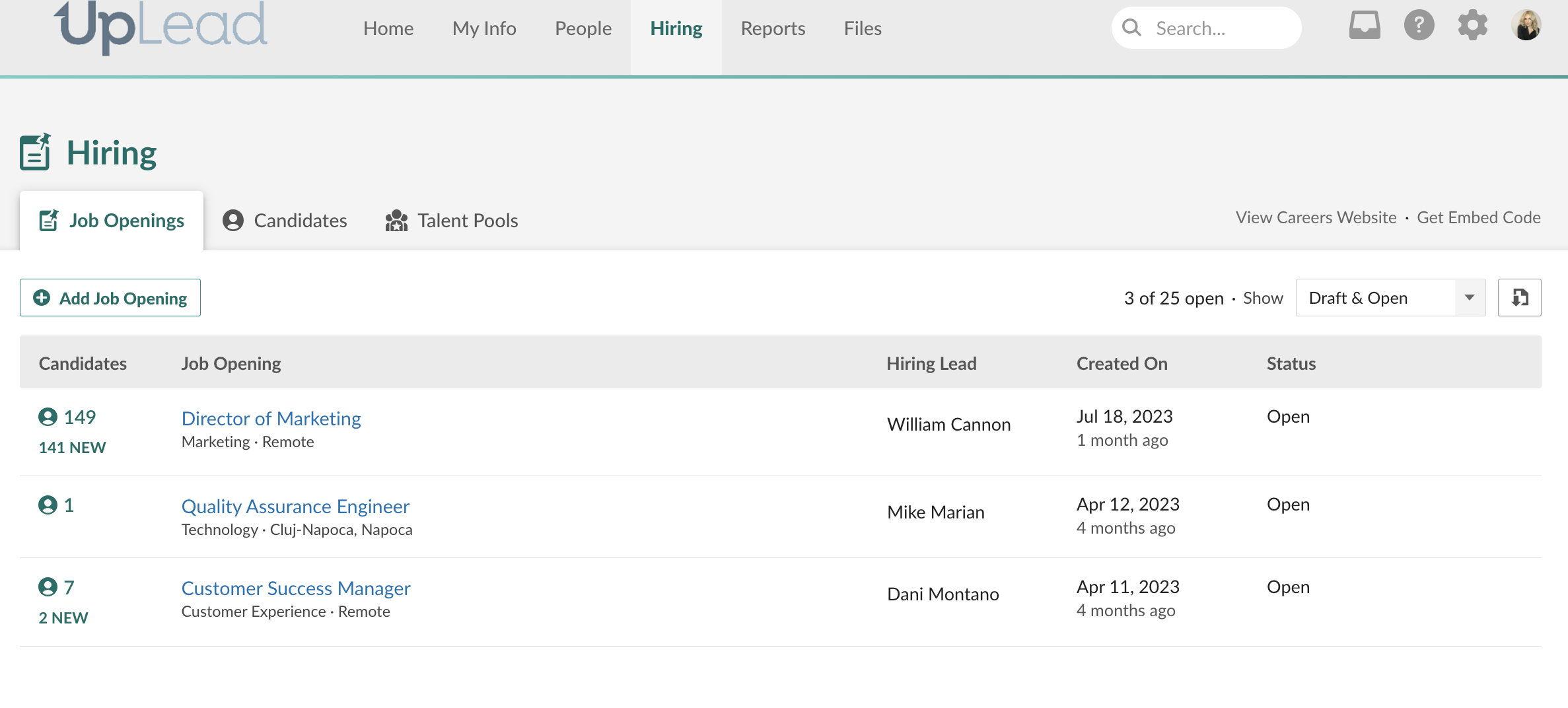
- BambooHR is easy to use and train employees on. BambooHR makes it very easy to create offer letters and email templates when it comes to recruiting.
- BambooHR makes it easy to recruit and keep track of candidates, and the stages they are in in the interview process.
- The BambooHR 'how can we help button' makes it super easy when you have a problem or a question to get a resolution.
We are a small organization with roughly only 25 employees but we need a tool that could do it all. When making this decision we compared tools that could sit as an ATS system combined with an HRIS system. Not only can BambooHR fit in those factors, it can also have benefits and payroll implemented in their system if we wanted to stop using our other payroll system. We have been using BambooHR since March 2023 but I had used it at a prior organization so that was an easy decision to move forward with it.
- I wish BambooHR let you have candidate scorecards when recruiting.
- BambooHR makes it easy to create onboarding documents but it does not always simplify the packets for each job function.
- I wish BambooHR had the ability to open and close jobs more fluidly similar to Greenhouse - multiple openings in one job code for tracking purposes.
BambooHR is a great product for a small growing organization that needs a product to do it all. Because we have a limited budget we needed to find an ATS that could also onboard and fit as a people management system. I think that BambooHR is cheaper and easier to use.
When buying a tool like BambooHR I think they should consider price (this was our number one driving factor), and scalability. As we continue to grow, BambooHR will be able to grow with us.
BambooHR has evolved over the years since I last used it. They have developed their reporting capabilities, added payroll and benefits to their system, as well as created a system to organize a 'talent pool'.
BambooHR is good for a company with less than 400 employees that is looking to grow their organization, and manage current employees.
BambooHR might not be a fit for companies that are larger than 600 employees or trying to make a lot of hires at any given time.

Bob

Bob is a global platform that can streamline pretty much everything an HR department needs to do, in a highly customizable manner.
PROS
- Offers excellent customization options for managing international operations, allowing seamless handling of diverse workflows such as time off requests, parental or other types of leave, and employment types across multiple countries.
- Notably, it includes intranet-like features that users appreciate, like posting 'shout-outs' and sharing content on a company home page.
- Robust integration capabilities enable the connection with other essential business tools.
- They have tons of modules, which makes them a real one-stop shop. Beyond Core HR, they have modules for most things People Ops-related.
- Bob is a fast-growing company and their product looks the part, as it has one of the sleekest-looking platforms in the HRMS space right now.
- Their payroll hub allows you to connect all your payroll systems, which works great if you want to pay people in multiple locations without switching providers.
CONS
- While functional, the reporting capabilities of Bob can be considered limited for an HRIS.
- As an HRIS, some users feel that certain modules, such as performance management and surveys, could benefit from more extensive options and customizable parameters.
- The user interface can be less intuitive in certain areas, requiring a slight learning curve for optimal utilization.
- Customer support is only offered via a chatbot and email.
- As to implementation, several users commented that they felt there could be more attention via personal walkthroughs provided at the beginning. Many had to resort to reading documentation and watching videos or just figuring things out by themselves.
- Pricing is only custom and available upon request, so you can’t just sign up, pay, and start using the tool.
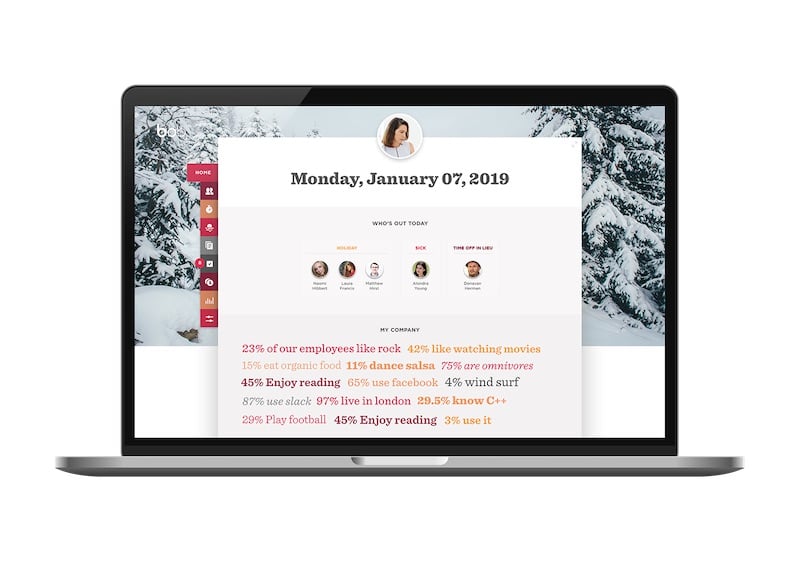
Bob, or HiBob, is a really interesting contender in the HRMS space. Their philosophy is to put the employee first, and you can see that in how easy the product is to use. Also, in various ways, this solution engages employees to better understand and cultivate culture. This is a great fit for forward-thinking HR departments that need tools like onboarding, time-tracking, payroll reports, time-off management, surveys, benefits, and much more.
Tufin, Yotpo Ltd., Fiverr, Happy Socks, Taptica
Bob offers custom pricing. They have flexible plans for growing companies and will work with you to offer the best possible cost.
Best For
Bob offers custom pricing. They have flexible plans for growing companies and will work with you to offer the best possible cost.
We use Bob everyday. It is an integral part of our business. The key workflows we use Bob for are hiring, onboarding, offboarding, internal mobility, employee engagement and assigning tasks.
As a startup company, I love the ability to automate my daily HR administrative tasks. I’m very impressed with the onboarding capabilities for both in office and remote hires. In addition, the ATS integration with Workable is great to streamline hiring.
We were introduced to HiBOB at an HR Technology convention. We were seeking software to automate our hiring workflow process. Bob allowed us to create customized workflows, and implement e-signature documents which drastically improved our onboarding process. Bob also was very useful in helping our HR team with our company reorganization.
It would be nice if Bob had its own ATS to eliminate the requirement for third-party software.
Bob is different from its competitors for several reasons. I find the user interface and experience to be more desirable than a few other platforms. Bob is easy to navigate and has the ability to customize my dashboard. Most importantly our new hires love the straightforward modern onboarding process.
The first thing people should look for is to determine if the tool aligns with your company needs and goals. People should also make sure the tool integrates with their existing tools i.e. ATS. The next feature to consider is the cost per employee. An ideal tool will offer reduced rates as your employee/user headcount increases.
Bob has evolved overtime to meet the new HR landscape and policies surrounding things such as the use of Ai. They continuously provide monthly newsletters with additional templates and tips for HR professionals. Bob also introduced a DEI dashboard.
Small to medium
Larger companies
Paycor
Paycor is a robust mid-market HR software for leaders at US-based companies that want their teams to save time with HR transactional tasks.
PROS
- Paycor web app and mobile version have been easy for employees to use.
- The employee self-service portal has good functionalities and is easy to navigate.
- Straightforward payroll processing.
- Scalable product with multiple plans for businesses with under 50 employees and custom plans for bigger teams.
- Frequently runs discount programs that cover setup fees.
- Paycor payroll solution and mobile app are both straightforward to use.
- Intuitive self-service employee portal.
- Offers multiple modules for small businesses and custom plans for teams with 50-1000 employees.
- Unlimited payrolls.
- Offers discounts frequently. Though not listed on their site, a free trial is available to those who contact the support team directly.
- On-demand pay is available for all plans.
- With the acquisition of the people development platform Verb, it has improved its employee learning experience.
CONS
- Customer support can be slow to respond.
- Recruiting tool is underdeveloped compared to other similar products.
- Undisclosed pricing. Free trial is available, but you have to reach out and request.
- Reporting and analytics capabilities are limited on lower-priced plans.
- Undisclosed pricing.
- Customer support is reported to be slow at times.
- It is not a good fit for teams with 1000+ employees or those requiring advanced customization to meet their unique requirements.
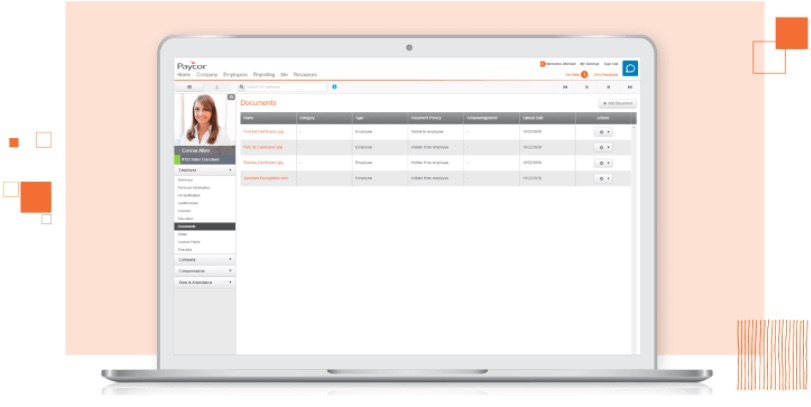
Paycor ticks all the boxes for the features we look for in an HRIS. The employee self-service portal is excellent; it makes tasks like reviewing or signing contracts or choosing benefits straightforward. Admin users are automatically informed about any updates to sensitive employee information.
They didn’t invent the wheel by offering mobile apps, but they are well-built and well-liked. They make it easy to access payroll, time and attendance, and other HR features while on the go.
Though large enterprises can use Paycor, we feel it’s best for SMBs to use it in conjunction with other core HR tools as they grow. Paycor offers multiple plan options for companies with fewer than 50 employees, so whether you only need a payroll solution or a full HR suite, Paycor may have a plan for you.
But our biggest concern about the software is customer reports that support can be quite slow to respond. We’ve also found the reporting capabilities for the lower-tier plans are limited. However, Paycor recently acquired Verb, a behavioral microlearning platform. In addition to bolstering its training and development capabilities, we hope to see improvements across the board in the following months.
Wendy’s, McDonald’s, Detroit Zoo, The Cincinnati Bengals, The YMCA.
The pricing of Paycor isn’t disclosed upfront. Contact a sales representative to get a custom quote.
Best For
While Paycor has features for global teams, it is a better option for companies in the U.S. with up to 1,000 employees, specifically those in manufacturing, healthcare, food and beverage, nonprofits, and professional sports organizations.
We use Paycor twice per month when payroll is due. They send reminders to make sure we don't forget to do the payroll as that would be terribly embarrassing if we missed a payroll. With many remote employees in different states, Paycor enables us to not have to research all of the various state tax laws. For that we are very thankful.
Easy to use. Keeps track of all state regulations and taxes. Provides solid customer assistance.
Paycor is an easy-to-use payroll solution for small businesses. Often, a small organization doesn't have a person who is dedicated to HR completely as they perform other duties. We wanted something that was easy to use and Paycor was.
Wish customer service got back to us quicker. Would like them to lower the price, although it is in line with others in the space. Would appreciate more proactive advice.
It has an easy-to-use and understandable interface.
Will it expand with you as your company expands? Do you need personal assistance?
It has continued to improve the product and keep abreast of the many disparate tax laws.
SMBs
I can't think of any.
Rippling
Rippling is an HRIS platform with a pleasing design and thoughtful UX that handles everything between onboarding and offboarding.
PROS
- All-in-one HRIS platform for employee management, PEO services, and IT management.
- 500 integrations.
- US and global full-service payroll.
- Responsive chat support.
- Straightforward payroll function.
- Has a mobile app.
- Does a great job catching compliance issues.
- All-in-one platform for employee management + PEO services offered, and even a suite of other IT products
- With 500 integrations, it’s very likely that they integrate with other key tools from your tech stack.
- Operates globally with any currency
- Workflow automation
- Analytics opportunities
- Provides a holistic view of company outflows—headcount costs included
CONS
- Very SMB-oriented.
- No phone support.
- Decent prices for the core HR tools, yet extra features (sold as add-ons) can be too pricey for some.
- The reporting function is not the most user-friendly.
- Some shortcomings are reported with benefit carriers, and users are limited to their partner ecosystem.
- Total buy-in to Rippling is essential
- Very SMB-oriented, in case you’re a larger company.
- New features tend to be buggy in ways that tech teams are not accustomed to fixing
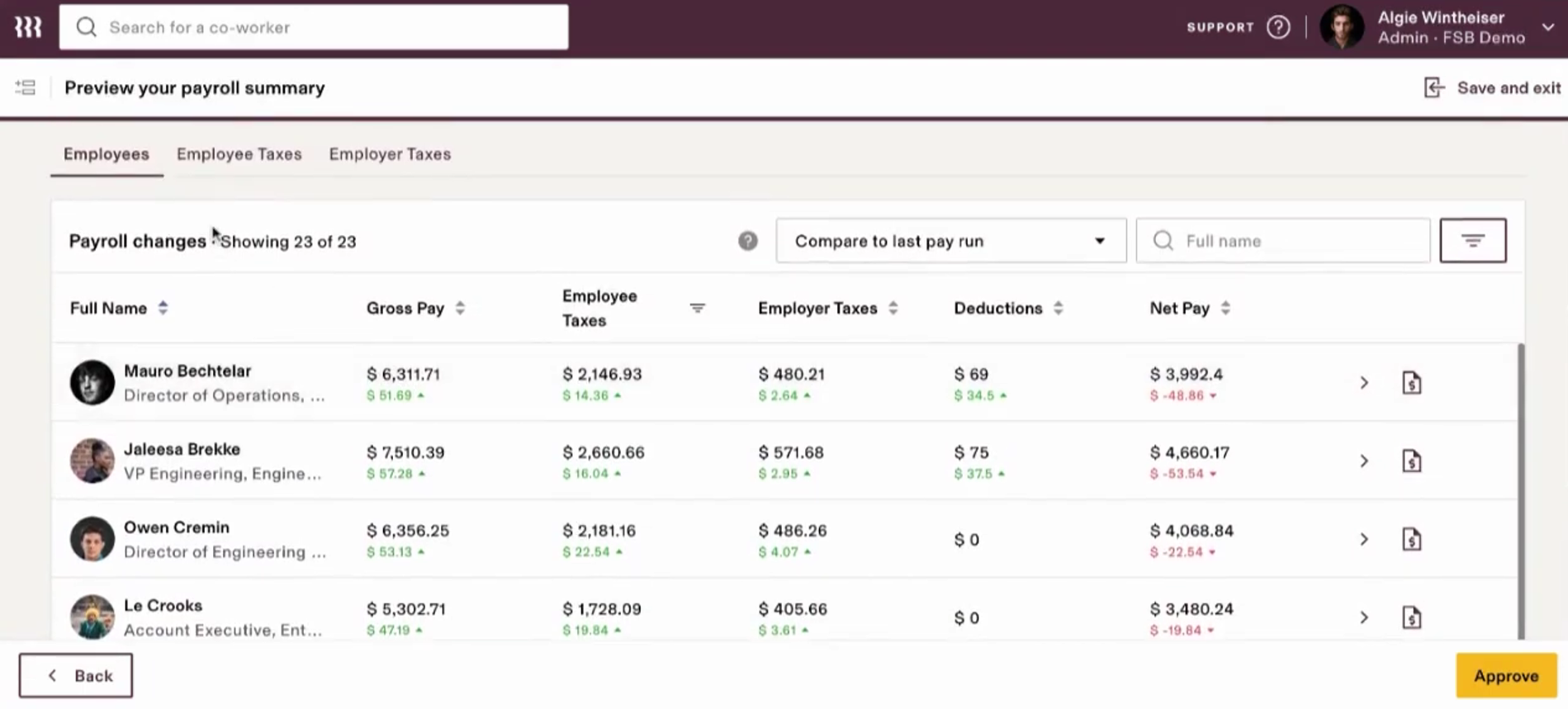
Rippling has gained traction with their product that focuses on helping SMBs manage HR and IT news with one platform.
Rippling’s focus is on automation and ease of use. In response to user feedback about problematic UX/UI, Rippling made significant improvements to the design of the web and app-based versions. The new design is a massive improvement and a big hit with our user testers.
Proxy, Dwell, Superhuman, Expensify, Checkr.
Rippling pricing starts at $8 per user per month. Rippling uses a per-employee-per-month pricing subscription model and has monthly base fees for some of its products.
Best For
Rippling works best for small and mid-sized businesses looking to manage HR, IT, and payroll in one place. The HRIS’s average customer size is between 25-150 employees.
We mainly used it for W2 and 1099 payroll, onboarding, offboarding, and reporting. For an added fee, you can utilize some of their workflow automation tools to optimize some of the more manual workflows.
- Domestic U.S. payroll: Rippling is recommended for a predominantly salaried workforce. There is a very basic timekeeping system that we utilized for our hourly non-exempt workforce for time off tracking and 1099 contractors. The salaried payroll is very easy to use; however, the state registration for payroll can be a bit complex. Reaching a payroll support person can also be a bit of a headache, especially during a payroll crunch, but there are also many helpful payroll support people. You can utilize chat, or they can call you to resolve issues. One of the biggest challenges we have faced was opening a payroll ticket and taking days, up to weeks, for it to close if it was a complicated issue. You do not get a dedicated customer support representative so definitely take that into consideration.
- International payroll: International Payroll: International Payroll is not supported, however, you can store HR Information for international employees. It's a bit more of a hassle to keep their information and turn off their payroll info, but helpful for having a full scope of the employee base.
- Onboarding / offboarding: The integration for onboarding with greenhouse ATS was a bit clunky. Names and basic information would transfer over from Greenhouse, but you would have to search the name on the Rippling end. Creating the onboarding packet was not too difficult, the user interface is pretty basic, but easy to set-up and administer for e-signature. Offboarding can be done in advance of a departure, and access points, notifying IT, etc. can be set up in an easy to use workflow. Departed employees can still access a limited version of their employee portal to see their W2s and Paystubs via Rippling after they've departed the company which is extremely useful.
- Laptop Inventory Management: We originally had paid for this service as we were a small HR team of 2 with no IT department at first. It's helpful to have as a service, but unfortunately it over promises and under delivers. There are frequent inventory shortages for laptops, so the best thing to do is purchase in bulk or purchase laptops to have on-site and send them out to new employees outside of the system. If you have your own IT department, in-house is a better way to go since this does cost a significant amount of additional charge.
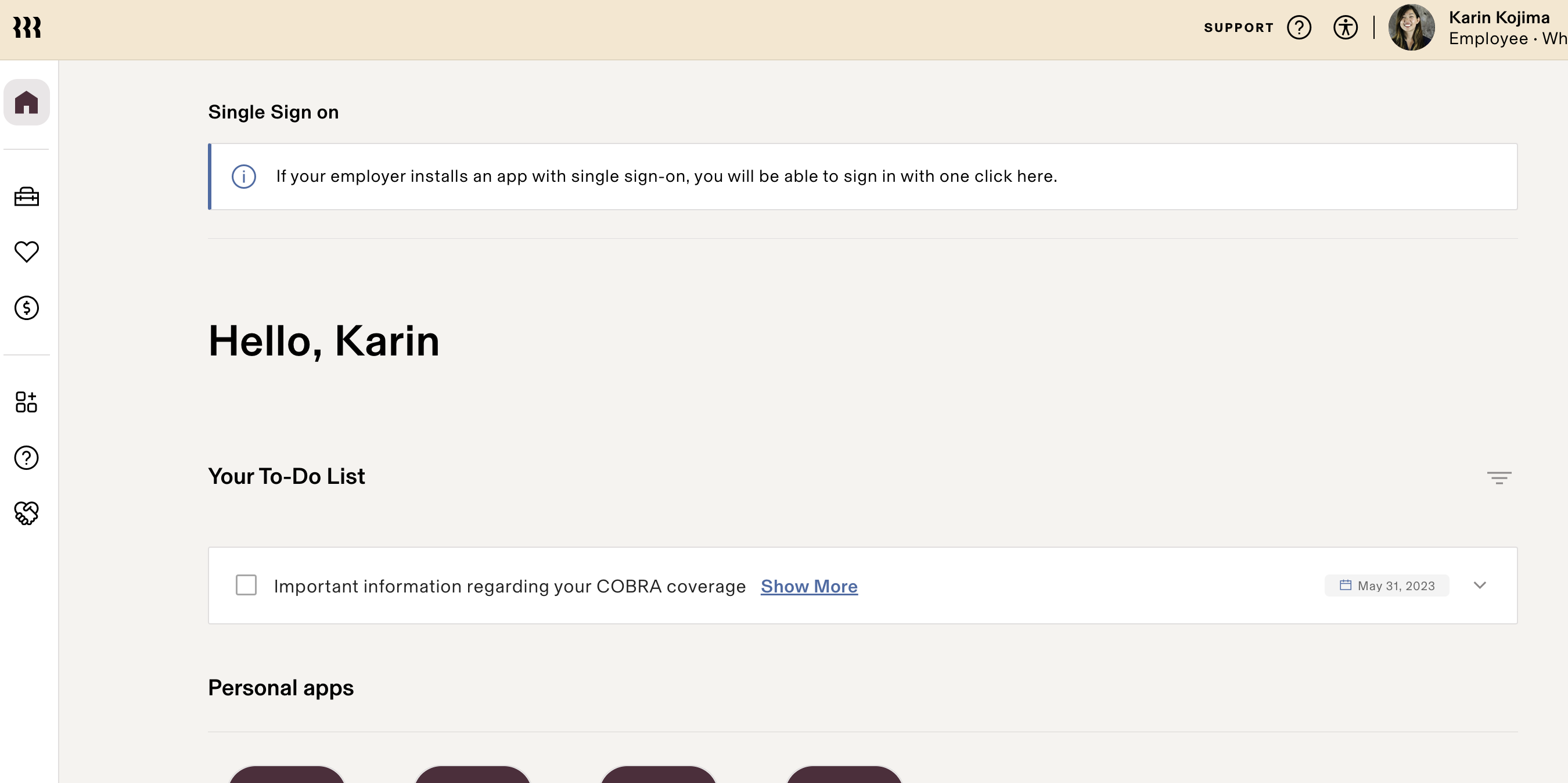
- I liked that Rippling provides robust reporting across their different functionalities.
- Rippling does a great job at making a user-friendly interface to navigate.
- I like that it has all the bells and whistles you need for a small to medium sized business.
We started off using Gusto as our Payroll/HRIS. Our team grew from under 50 to about 110 in 6 months. Unfortunately, we quickly outgrew Gusto's Benefits, Reporting, and HRIS capabilities.
A nearly all-in-one system is difficult to find. Coming from Gusto, we knew we wanted to keep our benefits, payroll, and HR information in one system, with great functional reporting across these data points. This cross functional data helped us create great reports that helped us visualize our YoY growth, retention rates, benefit enrollment data, headcount, and much more.
- They nickel and dime every part of the platform, so you'll end up with hidden costs for unlocking parts of the platform that are usually included in others, and you'll end up with a larger cost than you originally thought. Ask for an upfront detailed overview of the costs of all the modules.
- Subpar customer service with not a lot of dedicated support.
Overall, it's a good competitor for small to medium-sized HRIS solutions because it includes HRIS/Payroll capabilities. They extend into all facets of HCM, but they do payroll, benefits, and reporting best. I appreciate they delve into different avenues, but a perfect all-in-one is impossible, so it's best to stay with what you're best at. In terms of an "all-in-one" solution, if your team is under <500 employees, it's a decent solution. The platform and company is still growing, so be patient with changes and bugs. But overall, 7/10 experience utilizing Rippling. They do listen to customers, advocate for change within the system, and move quickly.
- Budget - Rippling can start off inexpensive, but when you add the bells and whistles, it can get quite expensive. Make sure to ask what each module costs independently.
- Payroll Audience - If your population includes a significant population of hourly time keeping needs, this may not be the best platform. You can also integrate various time tracking tools as well.
- All-in-One - Unfortunately, there still isn't a perfect solution. It's important to know which modules to prioritize. If you care about your payroll, HRIS, and benefits admin in one, this is a good system for a small to medium-sized company.
- Customer Support - If you need significant customer support, Rippling may not be the best fit. It was a challenge getting a hold of our reps at times. For payroll support, you don't get a dedicated person so it can be a challenge. If you prefer to have white-glove service here, this may not be the best unless things have changed.
- App Integrations - Rippling is a closed environment, meaning you cannot create your own integrations. However, they do have a lot of APIs available for many of the largely popular apps/tools. Most of our tech stack was already aligned to what we used within Rippling so it wasn't too difficult, but it's a serious point to consider for things like your accounting system, time tracking system, expense management, etc.
Since the time we started utilizing Rippling, they have implemented significant changes to their platform. They added PEO services, global payroll, LMS, pulse surveys, and a few other new functionalities. They truly are innovating to become the all-in-one mid-enterprise platform.
I believe Rippling is great for companies under 500 employees with a predominantly salaried workforce. This tends to be more common in tech centered environments. Also when you have a lean team around Payroll/HR, it can be a great system to utilize.
A predominantly hourly non-exempt workforce. I think the platform would not be great for 500+ or <50 employees. It would be expensive for <50 employees, and be too manual for 500+, even with its workflow automation because of the integrations not working properly.
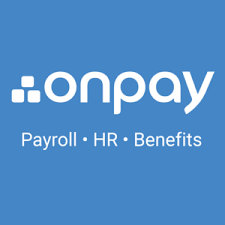
OnPay

OnPay has transparent pricing and is quite affordable for a solution that combines payroll, HR, and benefits. You get the setup and employee data migration for free. The platform won’t ever charge additional fees except when you add more employees.
PROS
- The employee self-service portal allows employees to view and manage basic payroll preferences, review HR documents, and request time off.
- Six permission levels allow you to grant specific users certain access to the software’s data.
- Automated onboarding within the employee self-service portal.
- Built-in essential HR tools include e-signing, customizable offer letters, I-9 and W-4 forms, HR guides, and legal templates.
- Auto centralizes employee database and company documents.
- Benefits include health and dental benefits in 50 states, in-house licensed brokers to handle life, vision, and disability insurance, and integrated 401(k) plans.
- Compensation management features unlimited monthly pay runs, multiple pay rates and schedules, and various options to pay employees with no extra fee.
CONS
- Accounting and time tracking are available when using third-party integrations.
- The mobile app version for employees is poorly rated for its incompetency.
- Limited integration options.
- No available features for learning management, recruiting functions, and training.
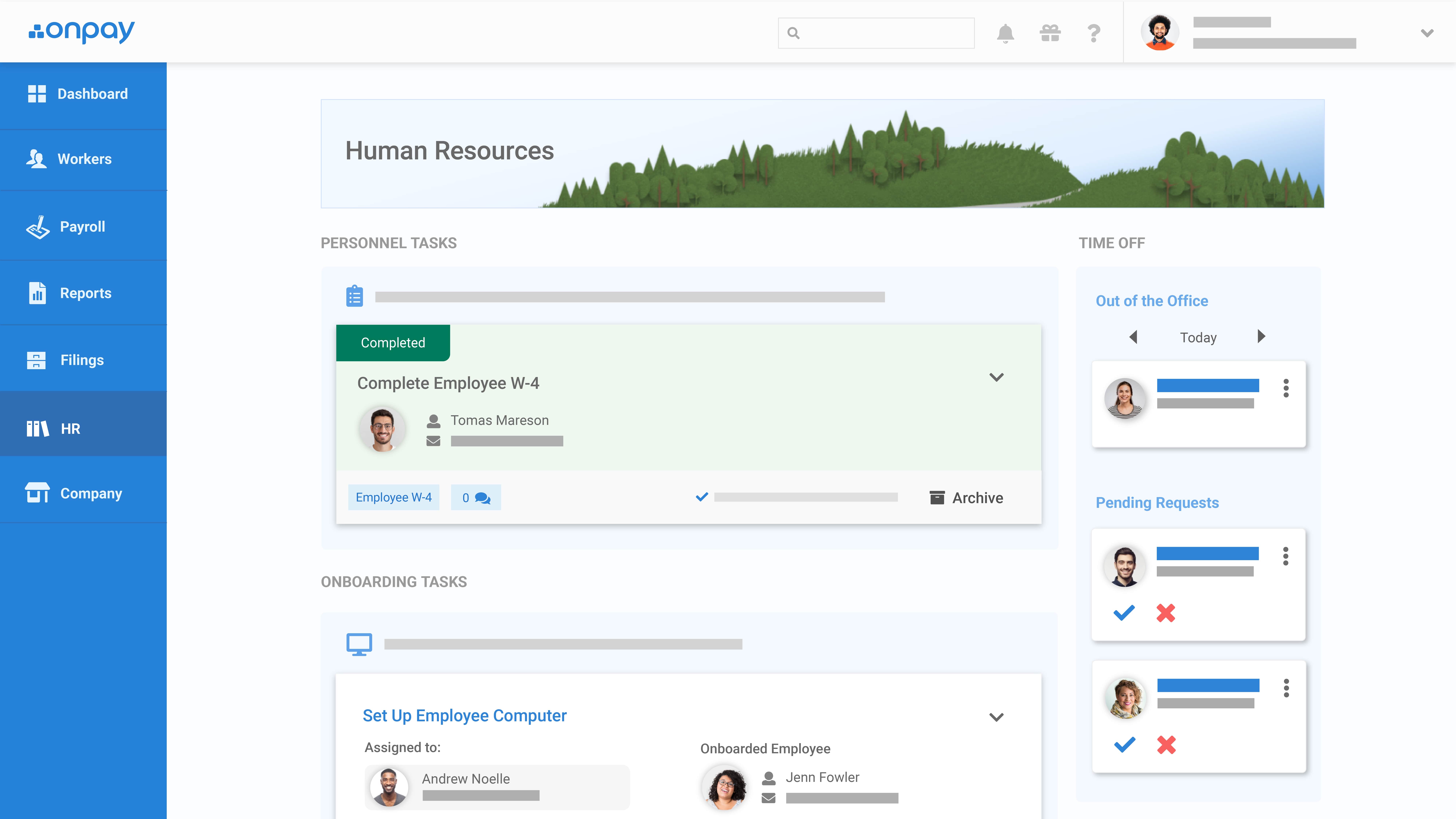
OnPay is an excellent option for teams with up to 500 employees due to its wealth of features and simple, affordable pricing. With one monthly fee, you get HR management, benefits administration, and payroll services.
Our favorite feature of the software is its compensation and benefits management capabilities. You don't have to calculate state and federal taxes and withholdings, as the platform will do it for you in compliance with regulations automatically. We encountered no issues when testing the software's payroll features, but what impresses us even more is its tax accuracy guarantee. If an OnPay error occurs, the platform takes responsibility for all the work with the tax agency, penalties, and fees to resolve the issue. We also used OnPay for tax form filing and payments and found it to be highly reliable. As for benefits tools, the platform is an excellent licensed health insurance broker and can help you select the right plans in all 50 states. We also noticed some well-known names, such as Vestwell and Guideline, listed as OnPay's 401(k) providers if you need retirement benefits for your employees.
OnPay's HR features include e-signing, sending offer letters, customizable checklists, PTO management, and self-onboarding, covering most essential HR tools. However, it lacks a native time tracking system, so you'll need to integrate it with software such as Deputy or QuickBooks Time for that capability. Another limitation to note is its integration options. Apart from the two time tracking tools mentioned, the software only connects to a few others: Xero, When I Work, Mineral, PosterElite, and Magnify.
- OnPay pricing consists of a base fee of $40 and $6 per employee per month.
- Software setup and employee data migration are offered for free.
- There’s a price calculator on the website for you to get the estimated cost.
- OnPay also has a one-month free trial.
Best For
SMBs looking for a budget-friendly solution that handles essential HR functions, advanced payroll, and benefits — simply and well. Agriculture businesses, churches, clergy, and nonprofits will likely get the most out of the software’s special payroll services for businesses in such industries.

Sage People

Sage People is a scalable and highly configurable cloud HR solution that helps manage People processes for global workforces. The tool features a recruitment module as well automation for essential HR workflows.
PROS
- Good range of workflows for globally-distributed teams
- Lots of local expertise from payroll and compliance consultants
- Good range of workflows for globally-distributed teams
- Lots of local expertise from payroll and compliance consultants
CONS
- Not many integrations
- Some users have found the mobile app to lack core functionalities
- Not many integrations
- Some users have found the mobile app to lack core functionalities
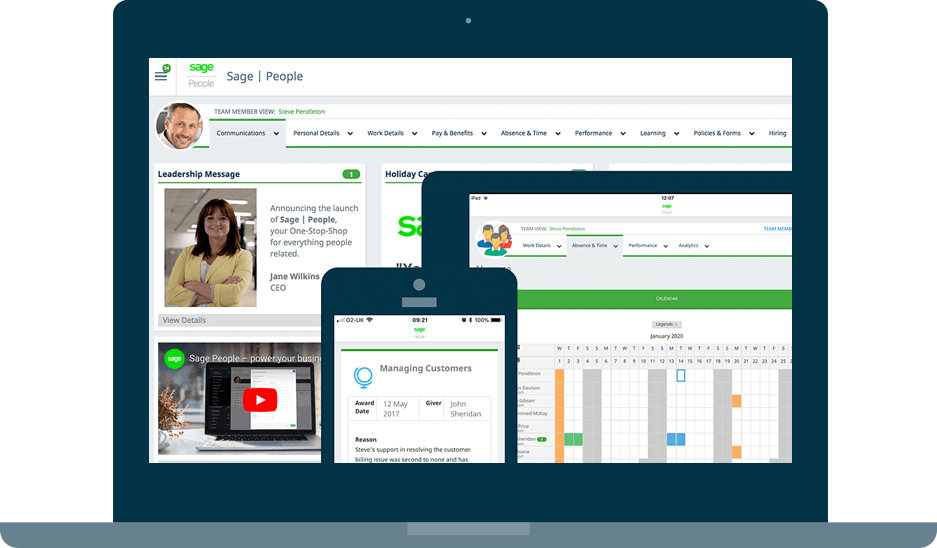
Sage's HRIS is a customizable core HR suite built on top of Salesforce. Their product covers applicants through alumni and is a great option for companies in the small to medium enterprise range (150 - 5k employees) that have a global presence. They boast a 95% retention rate across their 500 customers, the result of a broad product that also integrates with the rest of Sage's ERP suite.
CRU, Lovehoney, Showbrook Bank, Enigma Industrial Services
While the pricing for Sage People isn't disclosed, you can take an interactive tour and see the tool for yourself. Afterwards, you can get in touch with their team to get a customized quote.
Best For
SMBs with a distributed team, especially those that use Salesforce. Also medium enterprises with a global workforce.
I use Sage People,
- to record employees and all their employment history.
- to give employees access to their own information page.
- to provide various reports for internal teams and human resources teams.
- to feed databases and generate human resources dashboards.
- for managing employee databases from various countries and integration with other internal applications like DocuSign, Bonusly, payroll, etc.
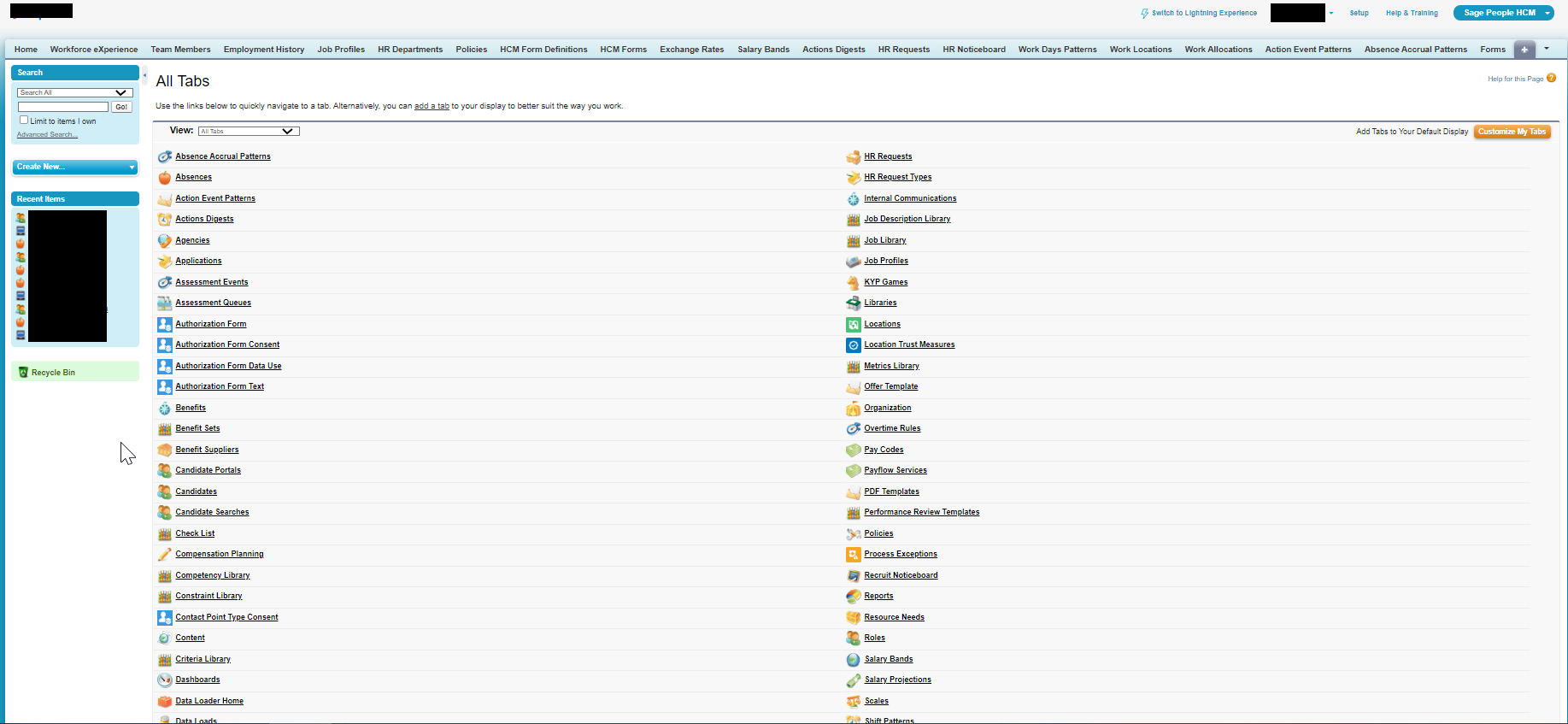
I like Sage People,
- as it has many features for example it generates extremely comprehensive and complete reports.
- as it has tools that allow me to batch-load data in a very easy and practical way.
- because it has very complete and functional support available to the user.
The tool was acquired for the registration database of employees. It was necessary to have a tool that could globally attend several countries. The tool had to be integrated with several applications like slack, DocuSign, financial force, etc. The system needs to be very complete in terms of reports and automation. I have been using the system for more than 1 year and 3 months.
Despite being complete the system has some limitations and in some countries with specific legislation is difficult to adapt to local rules. I can say that the system is quite complex and therefore some activities are quite difficult to perform and require some steps of attention.
I can say that the system has a lot of integrations with several other applications and platforms. Sage also stands out for its complete functionality in terms of reports. I also see the support offered to understand the system as a great differential, it is very complete.
Take into consideration a tool that can be globally adapted to many countries. Consider a tool that is widely possible to connect to other human resources applications and systems such as benefits, payroll, and other applications. Also, consider a tool that is easy to use and has a potential range of reports to generate.
I highlight that SAGE has released an updated version that can be used in parallel to the classic version, they call it Lightening with a more modern interface and some improved features.
In my point of view this tool is ideal for global organizations, with a human resources department that looks and takes care of your database and needs consistency and a reliable system with the ability to manage large volumes of data and generate practical reports and dashboards and requires integration with other internal systems in the company.
Small companies that do not need such a complex and complete system may not make much sense to use SAGE.

UKG

We picked Ultimate Kronos Group (UKG) because their platform represents decades of collective experience in HR ops and tech. UKG was the company formed from the merger of two well-established HR titans: Ultimate Software and Kronos Incorporated.
PROS
- Highly reliable, robust, well-thought-out suite of HR tools and 70 years cumulative experience in people tech
- Deep knowledge and context related to HCM and workforce management technology.
- Super robust product, packing years of experience with HCM and Workforce Management technology
- Since they offer UKG Pro for HRMS and UKG Ready for workforce management, you could arrive at a combination of products that suits many of your HR needs from the same set of tools.
CONS
- Lacks a unique selling point or specific focus compared to newer tools, making it less suitable for highly specialized or niche businesses.
- Relatively pricey, particularly for businesses with limited budgets.
- Most features are built for standard business operations, so niche industries or one-off needs cannot be accommodated.
- The platform may be overwhelming for those seeking a limited set of specific use cases
- Compared to newer tools, UKG Pro and UKG Ready tend to miss a unique selling point or a specific focus on a certain type of business. While they work great for bigger companies in all sorts of industries, very niche operations might have a hard time adapting to the tool.
- Similarly, UKG offers many solutions under one umbrella, so it's not the best fit if you're looking for only a handful of specific use cases.
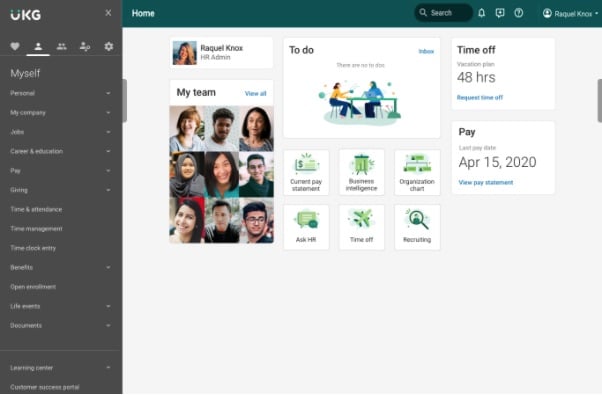
Specializing in core HR management functions, UKG is a highly renowned and widely adopted HCM suite. Over the years, it has undergone extensive testing and continuous development, resulting in an impressive array of modules that fully cover the standard set of HR tech necessities, such as payroll, benefits management, onboarding, and time-tracking.
This tool is highly configurable, allowing users to customize the platform to their specific administrative needs. This adaptability, coupled with the reliable support from the Ultimate Community, are the characteristics that impressed us most.
Admin users will appreciate the fine-grained control over user access, which enables robust data security by enabling tailored access permissions for different individuals and user groups.
Overall, the UI is visually appealing, but new users may be overwhelmed by option-saturated screens. To their credit, this overabundance of the interface signals a wealth of features and options.
The Ultimate Community feature offers a massive repository of information and insights drawn from the questions and answers of other users. Beyond being a simple record, it also allows users to seek assistance and interact with other current platform users, fostering a sense of collaboration.
This platform is great for most businesses with typical HR ops needs, but it is unable to address the needs of highly specialized teams. This shortcoming applies to edge cases, but lacking this adaptability means they cannot compete with some of the newer, more agile tools in this space.
It follows that the cost of the platform is aligned with their typical customer: the standardized organization operating in a well-known field. Some reports indicate that the starting price for every 5 users is approximately $600 annually, but with no pricing info available online we were unable to confirm.
Tesla, Marriott, Yamaha, Aramark, Puma, Sony Music, Samsung.
- Pricing for UKG is not available on their website. However, it is usually per-employee-per-month, either billed annually or monthly.
- Based on our research, UKG Pro licenses start around $600.00 per year for every 5 users.
- For detailed pricing information and a personalized quote, it is recommended to reach out to a sales representative at UKG Pro.
Best For
UKG is an excellent HR solution specifically designed for companies with a minimum of 51 employees in the Americas, EMEA, and Asia/Pacific regions.
I personally use the tool every day. The main thing I use the tool for is pulling reports about employee information. I use these reports to provide talent metrics to our executive leadership team. I also use the tool daily to review the org chart. This assists in integrating employees into other programs we use, like Officevibe and Linkedin Learning, which UKG does not directly integrate into. One other workflow we use UKG for is assigning HR tasks. You can create custom tasks, so we use it to keep track of tasks that are not related to UKG, like removing people from other programs when they are offboarded.
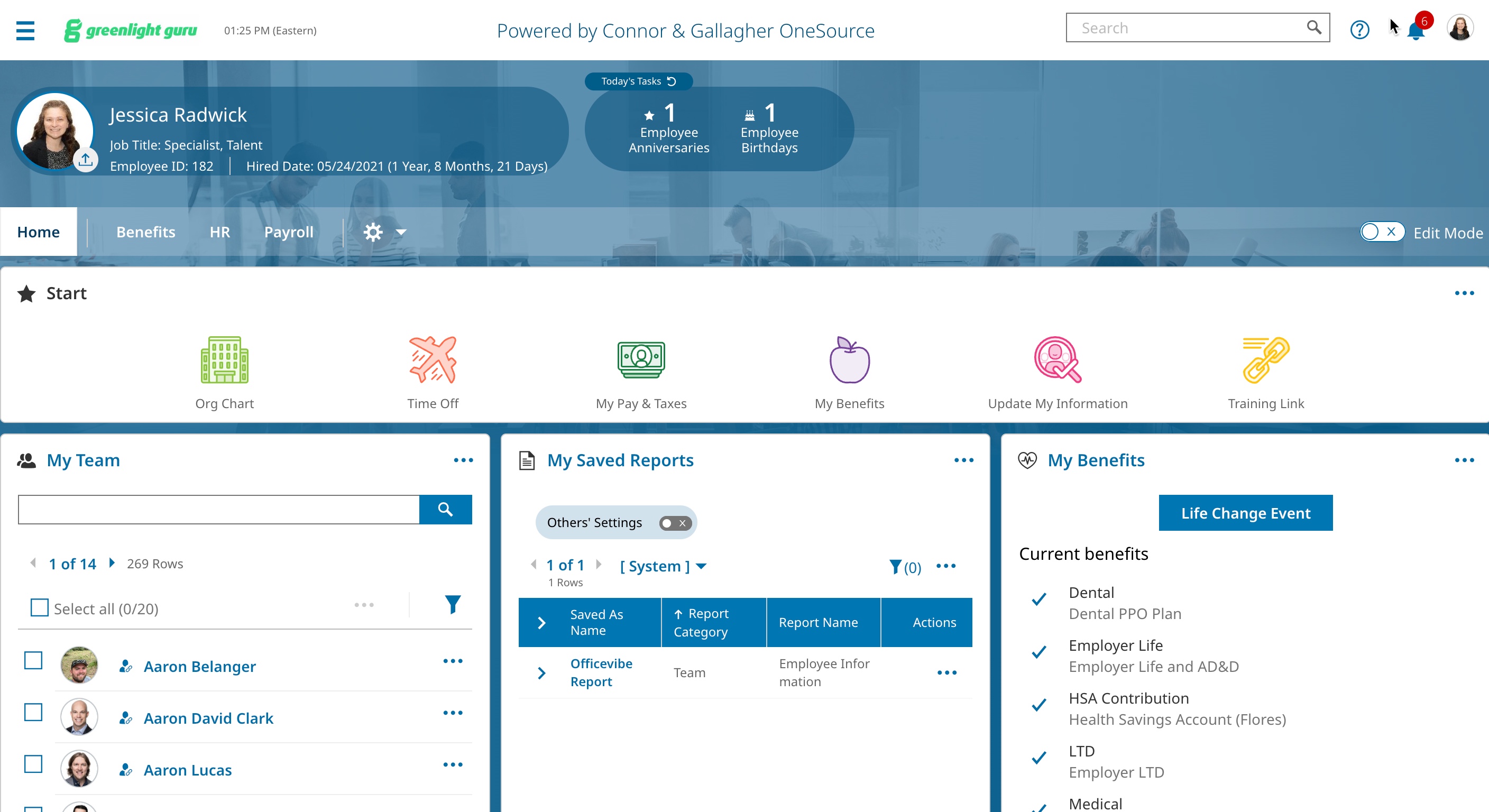
Honestly, I do not like UKG, but these are 3 pros:
- The org chart is nice to be able to see who each person reports to (although only HR is able to see it)
- The HR checklist tasks are useful to keep track of tasks.
- The ability to filter reports before exporting is useful.
Our organization bought UKG to replace our old HRIS. We previously were with BambooHR but moved to UKG so that we could move payroll internally. We have been using the tool for one year. This tool provides the bare minimum needed for an HRIS as we have the basic version. We have used the tool for one year, but we are already looking for a new HRIS to move to because we have had a very bad experience with both the tool and customer support. I personally use the tool daily to run reports and review the organization chart.
- Pulling reports is so complicated. It is not streamlined at all.
- When conducting payroll, we get LOTS of error flags that we have to go through (and by LOTS I mean 75-100)
- The org chart is only accessible by the HR dept.
- It is just not user-friendly. I often have to hold the hands of our employees to show them how to submit a PTO request, change their personal info, etc.
This tool is much worse than similar tools in my opinion. The reason we switched was so that we could have an internal payroll solution, but after just 1 year we are already looking for a different tool.
The first criteria people should consider is whether the tool meets all of their requirements. That is the reason we switched to UKG because our old system did not meet our new requirements. Next, people should consider whether it has add-ons that support their business. We are looking for a system that has a built-in performance management solution, as well as L&D functions.
No. The customer support has not been helpful to us.
Small companies that want to do internal payroll but do not need all of the bells and whistles (and who do not mind spending a lot of time on payroll and pulling reports). I do not recommend the tool.
Most organizations. Any org that wants additional tools beyond the bare minimum. Any org that is big enough to need an org chart. We are at 250 and it is already an inefficient tool for us.

Sapling

Modern and user-friendly, the Sapling platform stands out as one of the few HRISs tailored to meet the needs of remote workplaces. Two standout elements are its exceptional onboarding capabilities and efficient workflow automation.
PROS
- The platform maintains a comprehensive record of all HR process changes, making it invaluable for audits and data compliance needs.
- It enables talent development through e-learning modules and gamified courses.
- The platform offers remarkable flexibility which makes it a great fit for small and scaling teams.
- The platform keeps track of all changes done to HR processes; useful in case of audits and to ensure data compliance.
- Includes talent-development features through the e-learning module, such as gamification of certain courses.
- Good bet for small and scaling teams given the flexibility of the platform.
- The tool also has remote team-focused features process auto-assigning.
CONS
- Some reports suggest the support team is slow to respond
- Users occasionally encountered troubles with integrations
- Integrations are somewhat limited and must be handled by staff that is comfortable working with the API or webhooks
- Several users have reported that the support team can be slow to respond to requests for assistance.
- Although it might not be completely on Sapling's hands, other users during are research reported troubles with the integrations to software like ADP.
- Additionally, the integrations are somewhat limited and you need to work with either an API or webhooks with some of the most trusted HR tools out there.
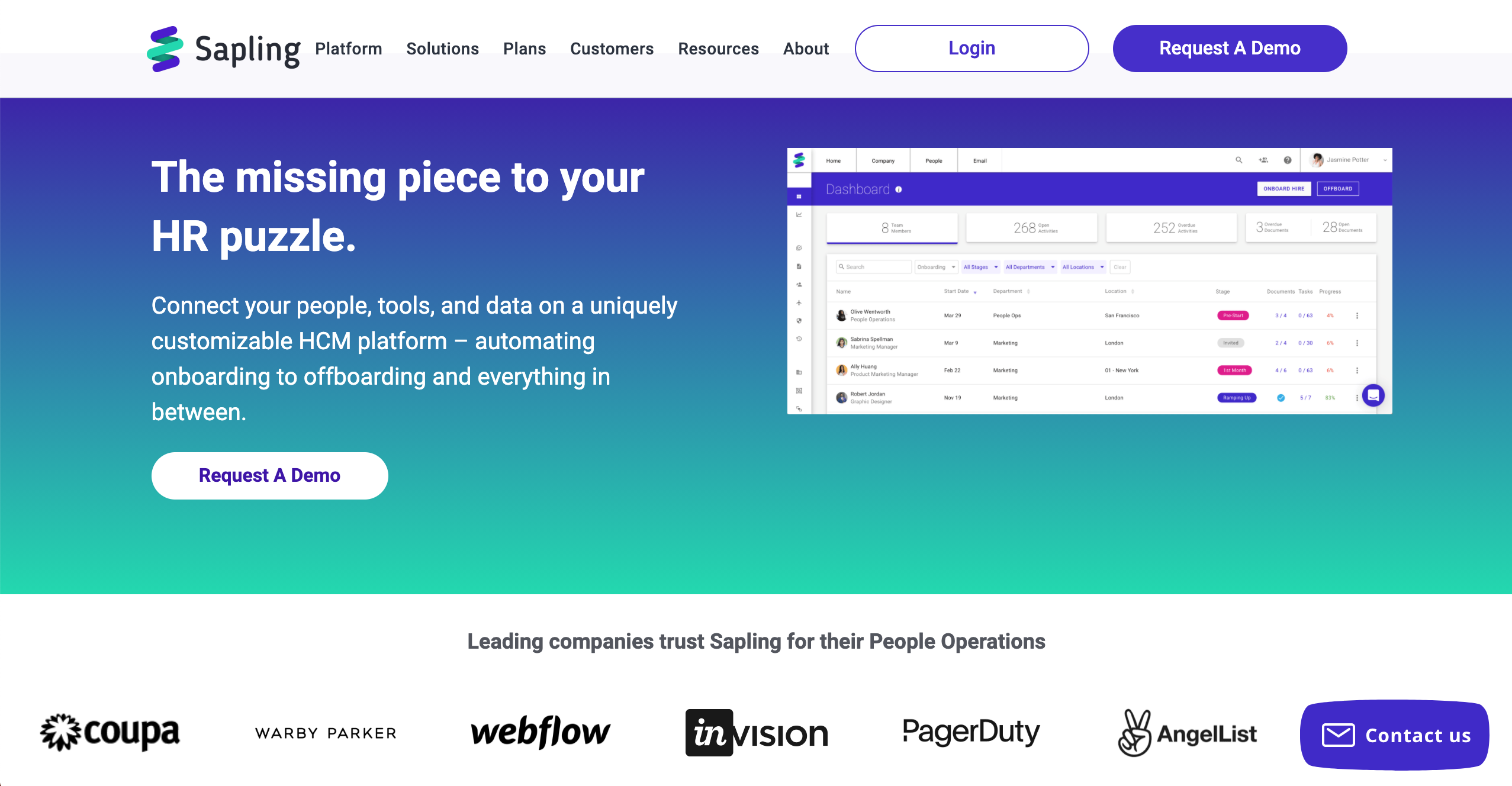
Although they started as an HR onboarding platform, Sapling has quickly grown into a remote-first HRIS with an impressive client list. Their full product keeps garnering zealous users and adding up features, currently offering tools like people admin, an intranet, a survey and feedback module, profile templates, and all sorts of integrations.
One of Sapling’s main strengths is their workflow automation. Their goal is to help People teams improve the employee experience while saving man hours and bringing remote teams together.
Coupa, Warby Parker, Webflow, Digital Ocean, PagerDuty
Sapling's pricing varies depending on which modules you'd get. You can start with the People Operations Platform, and then add the Essential and/or Premium modules. The final price will depend on the applicable platform fee, plus a per-user-per-month fee. To give you an idea, the minimum annual fee is $4,000 USD.
Best For
Sapling is aimed primarily at mid-sized organizations (50-2000 employees) distributed internationally.
Sapling is especially important when we bring in a new employee, and it is used regularly in the first 90 days to build the whole onboarding experience. We use it to make sure every important communication and event happens from the point of the offer to the first few days, and that those who are responsible for that are involved. So, offer letters, welcome packages and gifts, welcome emails and outreach calls, training agendas, and team assignments are all handled through Sapling.
Also, all the initial paperwork and signatures are centralized and handled through Sapling, so that part is very smooth for everyone involved. Throughout the introductory period, we use it to be sure surveys are sent at the appropriate intervals (30/60/90 days) to get feedback and ensure the employee feels heard and valued and to address any areas they need help.
We also found that Sapling was very helpful in providing content to build initial connections between co-workers, connecting them on a one-to-one basis, and including new hires in events.
It was easy to learn and navigate so everyone enjoyed using it.
It is customizable which is particularly helpful in creating individualized onboarding plans.
Information is easy to access, and data is readily available for managers, such as upcoming tasks and events, employee information, and employee feedback.
We chose Sapling to improve our onboarding. We had gotten feedback from staff that onboarding was not well coordinated. We also had more recent hire turnover than we felt was acceptable, and that it was likely connected to onboarding. We had problems establishing not just the critical first few days but also the introductory 90-day experience in which relationships are formed, the tone is set and the groundwork for long-term employment is established. We used it for a year.
It would be nicer to see some data within the platform, rather than having it generated as a report you open outside the system.
The org chart was a bit cumbersome to use.
More resources for employee experience after onboarding available would improve it.
The guidance Sapling provides to managers regarding onboarding seems unique and much more in-depth than other products. For onboarding, I would choose Sapling over other onboarding products and features, as it is very thorough and instructive regarding what onboarding should be.
If you don't hire often, the best part about this product may not be worth the investment. However, if you do have a growing or often changing team, Sapling could be the difference between losing a good new hire in the first 3 months or retaining them for years. So, if turnover is a problem, and if your onboarding has no structure, this is something to seriously consider.
Like any tool, it requires that people buy in and use it for it to accomplish what it sets out to accomplish, so you need to prepare your people for change if introducing a new way to handle onboarding via Sapling.
I believe the product has expanded and now features more performance management options as well.
This is a very good product for growing companies, startups that have a lot of hiring, and companies that need to address turnover issues.
Companies with little or infrequent hiring or turnover may not benefit.

Namely

Namely’s comprehensive HR software packs features for onboarding, talent management, time-off tracking, and performance management. On top of that, companies can opt for their managed services for payroll and benefits administration.
PROS
- The majority of users can navigate Namely without any issues. They find the UI to be intuitive and clean, even though the platform has lots of features.
- Namely’s employee onboarding module gets a lot of praise from users. It features an easy-to-follow wizard, which helps new hires get on quickly and be clear on what they need to do.
- Besides the platform’s built-in features for data management, recruiting, onboarding, time off tracking, payroll, and benefits administration, there are also managed payroll and benefits administration services you can opt for to reduce the burden on your internal teams.
- The majority of users are able to navigate Namely without any issues. They find the UI to be intuitive and clean, despite the fact that the platform has lots of features.
- Namely’s employee onboarding module gets a alot of praise from users. It features an easy-to-follow wizard, which helps new hires get on quickly and be clear on what they need to do.
- Besides the platform’s built in features for data management, recruiting, onboarding, time off tracking, payroll and benefits administration, there are also managed payroll and benefits administration services you can opt for to reduce the burden on your internal teams.
CONS
- Namely primarily operates in the U.S., so if you’re looking for a global payroll and benefits provider, this platform isn’t for you.
- Though many praise the platform’s ease of use, implementing it takes a long time. Namely’s own team says that an average implementation takes between 6-8 weeks.
- For a platform of Namely’s size, there currently aren’t any features that focus on employee development such as skill training, career pathing, succession planning, etc.
- You’ll need to check beforehand if Namely can work with your existing benefits provider if you have one. There have been a few reports (but not few enough to ignore) about Namely’s team convincing customers to change their benefits provider to providers that charged them more.
- Namely primarily operates in the U.S., which means if you’re looking for a global payroll and benefits provider, this platform isn’t for you.
- Though many praise the platform’s ease of use, it does take long to implement it. Namely’s own team says that an average implementation takes between 6-8 weeks.
- For a platform of Namely’s size, there currently aren’t any features that focus on employee development such as skill training, career pathing, succession planning etc.
- You’ll need to check beforehand if Namely can work with your existing benefits provider, if you have one. There have been a few reports (but not few enough to ignore) about Namely’s team convincing customers to change their benefits provider to providers that charged them more.
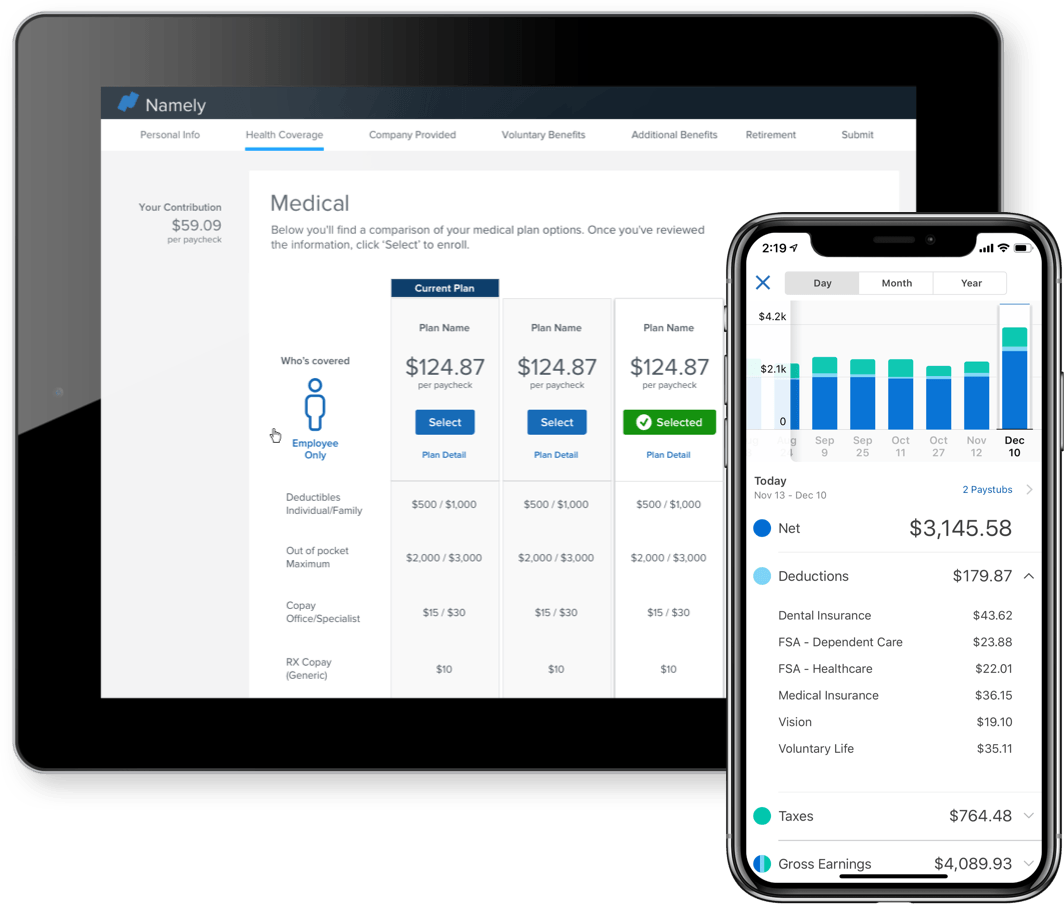
Namely has quickly become a top HR software for the mid-market. With built-in modules, Namely facilitates several HR processes, including employee data management, payroll processing, benefits administration, time and attendance tracking, and performance management. This integrated approach increases efficiency and reduces the need for multiple systems.
Besides what’s visible from the employer or admin side, Namely empowers employees to access and update their information, request time off, and view pay stubs through a dedicated employee self-service portal. Another near thing about Namely is its robust reporting and analytics module, giving you the reports you need and insights on the latest market trends.
Greenhouse, MacStadium, and OneLogin are among Namely’s 1000+ customers.
Namely’s pricing varies according to the modules you want to use. Their Sales team can give you a breakdown of how much it’ll cost you if you book a demo.
Best For
Mid-sized companies in any industry, but mostly in the United States.
I used Namely for every payroll of course, but also onboarding staff and making sure they are set up in payroll. Additionally, things like getting employees data regarding payroll such as w2s was much easier. It was especially helpful that our staff can self-serve, which in a company with a small HR department is critical. It was really easy for them to learn, and employees are able to enter PTO requests and track their balances without having to reach out to an HR professional. So that feature was used throughout the company every week. Also, the social feature was appreciated by the staff, such as seeing coworkers' birthdays and anniversary, so they can congratulate and interact.
I really liked the fact that our staff, who had never used any kind of HRIS before, was able to pick up on this so easily and didn't have trouble or need intensive instruction. I also liked the degree to which they were able to solve problems and access information on their own. I also felt the onboarding features were robust and easy to use.
At the time we switched to Namely we didn't have an HRIS and were manually doing everything from onboarding to payroll. Since we were growing, we needed a proper system. It definitely made things like reporting and providing employee data far more efficient and accurate. Also, the onboarding process was easy and saved a lot of time and prevented overlooked details and errors. The staff also liked using it and clocking in and out became easier with fewer mistakes. Once it was all set up, running payroll, making payroll changes, and accessing payroll records was much faster, easier and problems became rare. I used it for a year.
When I needed customer service, it wasn't the best I have ever experienced or the quickest, with a lot of different representatives involved of varying knowledge and understanding. I think better built in help resources would improve the product overall. I didn't find the benefits administration easy to use either.
I have used many similar tools and feel like Namely is a solid system compared to similar products. I don't think it is the very best, as it did lack some features such as an ATS, but for a smaller company these may not be as needed. The ease of use was a bit better than others, but the customer support needed improvement. Overall, I was happy with it.
People should consider what features they may need, and compare them to similar tools, since there are similar products with more features. Also, they should consider the size of the company, since Namely is best for small to medium sized organizations. If people are without any kind of tool like this, they should consider the cost involved is worth the many efficiencies they will gain from employing Namely.
In the time I used Namely, I think they did improve the customer service somewhat, which was a problem in the beginning. This is important because the work done in Namely is often time sensitive, such as payroll, and problems can have a major impact on staff, so customer service is critical.
I think this is perfect for small companies with employees who need an easy-to-use tool. It is great for companies who have never used a system like this before because the user interface is very intuitive.
Very large companies that do a great deal of hiring may find Namely not robust enough and lacking in certain features.

Zenefits

Zenefits is oriented to businesses in the US market. The platform carries almost anything a startup or small team can ask for in an HRIS with an intuitive design and a very reasonable cost.
PROS
- Provides full-service management of employee records, automated payroll, and benefits.
- Eye-pleasing UI that is also highly rated for its ease of use.
- The pricing plans allow you to pay and add certain modules when you need them or eliminate them if you don’t.
- Relatively cheap compared to similar products.
- Payroll works for full-time employees, part-time employees, and 1099s.
- Offers a free trial and no setup fee.
- Has a mobile app.
- It’s one of the top names in HR tech and payroll software for American small businesses.
- Their platform is one of the best-looking and easiest to figure out among the sector.
- Zenefits can grow with you. Its pricing plans allow you to pay and tweak as you go, add certain modules when you need them, or get rid of them if you don’t.
CONS
- Oriented to small businesses in the US.
- Payroll with unlimited pay runs is offered as an add-on.
- Basic customization and integration options.
- Tax filings, at times, don’t work well for multi-state teams.
- Doesn’t provide phone support or dedicated account managers. Response time on customer service can be too lengthy.
- As oriented to small businesses as the tool is, it doesn’t give you the chance to create a custom bundle of the services and/or modules you’d like to have. For instance, Zenefits does not offer a standalone ACA module. Therefore, you will need to purchase an entire HRIS plan if you want to access that offering.
- In addition, Zenefits focuses on small to mid sized companies. If you're an enterprise organization, you may want to consider another option.
- Zenefits is also rather focused on the US market at this point. So, if your team is mostly in another country and you need more of a local know-how, it might not be the best bet for certain modules like payroll and benefits.
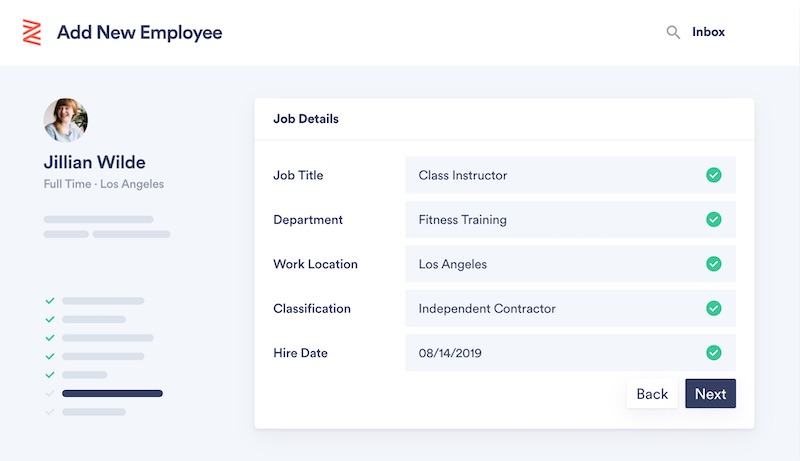
Zenefits can take care of HR processes like onboarding, offboarding, benefits, payroll, and performance reviews.
The HR software’s average customer size is under 50 employees, which means that the user experience is thought out not only for human resources staff but is easy and quick enough for managers or executives who need to take care of some HR tasks.
One of our favorite parts about demoing Zenefits was noticing the simplicity of the HRIS and its helpful employee directory. Zenefits is also known among small teams for its affordable price. While the software doesn’t offer a custom plan, it provides users with multiple add-on services, from Recruiting to Payroll, at a transparent price to enhance the platform’s base plan.
Quora, Universal Group, Reddit, Asana.
Zenefits has three base plans. When billed annually:
- Essentials plan costs $8 per month per employee.
- Growth plan costs $16 per month per employee.
- Zen plan costs $21 per month per employee.
- Add-ons are available at $5 per month per employee.
Best For
Zenefits is made for US-based startups and SMBs that are looking for a budget-friendly HRIS that can carry several HR services.
I use Zenefits at least once a week to update employee information. I approve vacations and time off for staff. The HR team adds new employees by setting up basic information. I sit with new hires to learn the system. I also manage processing 1099s/W2s with the company.
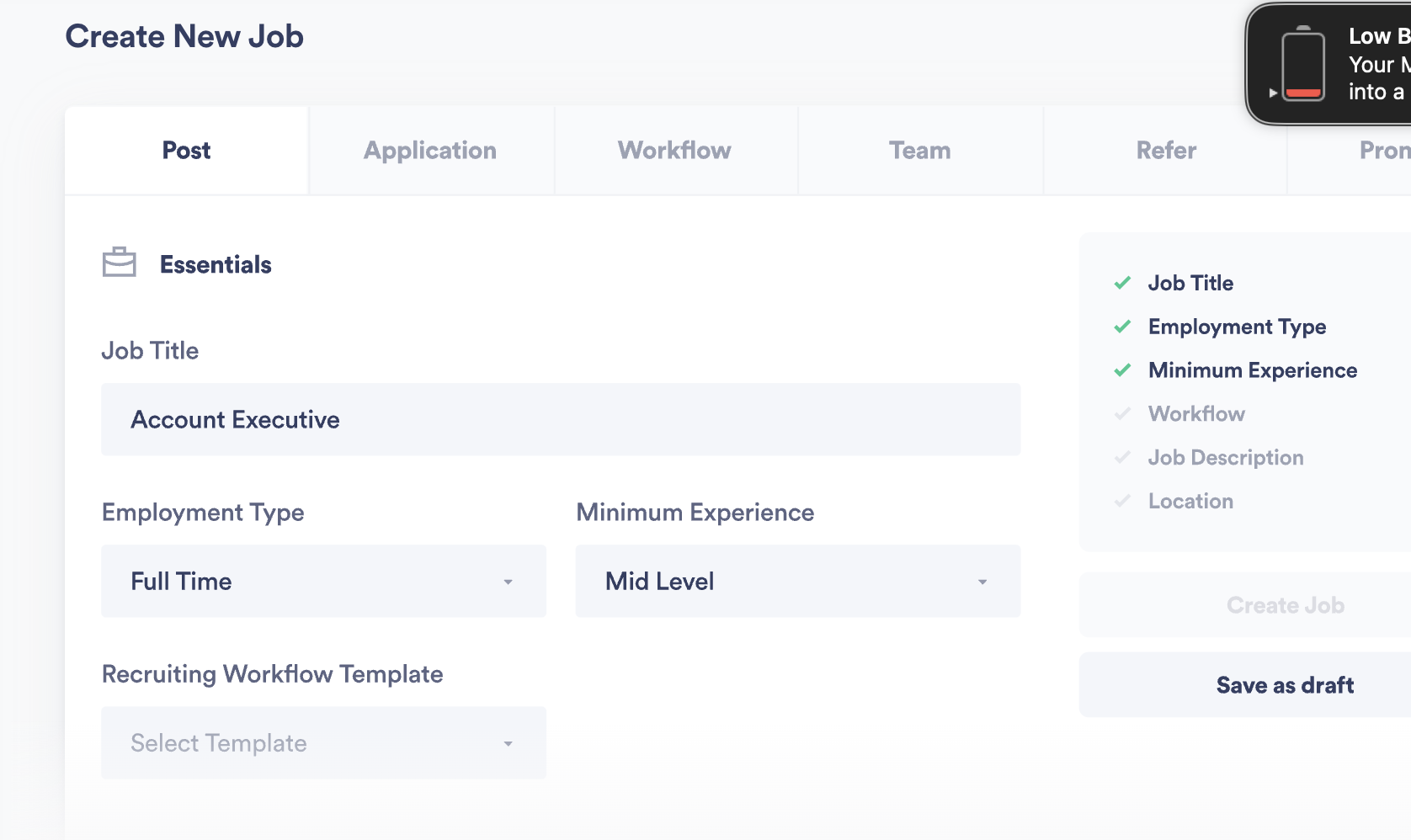
Zenefits is easy to use. The mobile app is very convenient and popular with employees. The platform is also very affordable.
We purchased Zenefits to handle onboarding for new employees. Zenefits allows you to manage many of the processes required for employees. Zenefits has a mobile app that streamlined access for staff to information like PTO, insurance information, and timekeeping. I have used the service for 3 years.
Zenefits relies on chat assistance and it can be inconvenient to wait for a response. The payroll processing can be a little tricky as you have to recheck data. Email notifications can be improved as they sometimes don't send at the appropriate time.
Zenefits is a great tool and comparable to others like Gusto and BambooHR. I feel that there are more comprehensive programs but the price point is very fair.
Do you want a simple program that handles all major HR, Benefit and Payroll needs? Do you need consistent access to tech support? Do you have a dedicated person to troubleshoot and verify data?
Zenefits has improved their app and their processing time for updates in the system.
Zenefits is best for small/mid sized businesses and independent contractors.
It is not a good fit for large or multinational businesses.
What are the benefits of having a top HRIS system?
We like to start with the “why?” behind any piece of software. With the HRIS, many assume that the answer is simple: it’s a must-have because a database that tracks your employee information is necessary. In fact, buying and using an HRIS is not the no-brainer choice it’s made out to be. It is a major strategic decision that requires a lot of time, thought, and buy-in, and in some cases, it’s just not the right tool for the job. That said, we’ve seen HRIS systems offer tremendous benefits when they are adopted at the right place and time.
Here are the key benefits of using a top-notch HRIS, whether you're a small business or Fortune 500.
Save Time with Automation: By automating recurring tasks like benefits, payroll administration, employee onboarding, time tracking, and attendance management, your HRIS helps make tedious HR processes quick, simple, and less prone to error. According to Nucleus research, companies that do use HR automation reported 67% faster new hire onboarding and 90% time savings on admin work.
According to Jones, if an organization has at least one employee whose full-time job it is to manage people systems and benefits administration, then it is time to start using an HRIS.
Improve the Employee Experience: An HRIS doesn’t just benefit your business and bottom line. It’s also a direct asset for your employees. With a user-friendly employee portal, your employees can navigate benefits options easily, review and update personal information, manage requests for time off, and much more. Employees who feel their employers’ onboarding software is effective are five times more likely to report high levels of engagement
Employee Performance: Beyond simply reviewing conduct and achievements, your HR system can actually drive employee performance. Performance reviews, engagement surveys, performance management capabilities, and customizable integrations with other tools can all be used to build culture and turn company values from ideas to action. Statistically, 72% of HR generalists engaging in self-service HRIS reported a lighter workload.
Increase Compliance: If you are careful with the setup and initial data entry, an HRIS can significantly improve your data accuracy and accessibility. In addition to helping out in a pinch, data accuracy, and task automation support compliance year-round. Automation results in fewer human errors. Many vendors do a great job of staying on top of changes in laws and regulations, keeping you in the loop, and updating their products accordingly.
Better Organization: If a team’s starting point is pencil and paper, using an HRIS will alleviate some data security risks and the hassle of sifting through physical files. For teams who have moved beyond the paper files to a patchwork of spreadsheets and other tools, buying a complete HR suite will help keep everything in the same place.
Richey shared her personal experience with this problem, and how an HRIS solved it.
Early on, her company used multiple tools for people processes: one tool for payroll, one for benefits, one for LMS, one for performance management, etc. Does this sound familiar? She knew it was time for an HRIS.
First, she identified the needed features and set her team off with a headstart and a list of non-negotiables. The result: they identified the right tool for the right price, and today, they save hours each month by not having to switch from one app to another, build integrations, or transfer info.
Streamline the Hiring Process: Some HRIS tools can also act as lightweight ATS, and some have a full-fledged ATS built-in. These features allow you to easily collect resumes, review candidate info, and speed up employee onboarding and training, providing new hires with a seamless transition into your company. Custom workflows also help ensure that the onboarding process does not overlook key steps or necessary documents.
Business Intelligence: Analyzing data metrics becomes increasingly important as your business grows. By creating custom reports, your HRIS makes it easy for your HR team to analyze hiring costs, calculate turnover, employee engagement, and ultimately use data to help inform business decisions.
Workforce Management: The top tools come from best-in-class HR technology companies. Progressive, forward-thinking HR departments can count on an HRIS platform for human capital management.
For example, employee engagement is sometimes built right into an HRIS or HRMS (human resource management software), along with intuitive employee onboarding, easy-to-access payroll and benefits, mobile first-time and attendance, and payroll management. This is done through a cloud-based service that automatically updates as new modules roll out.
Common Pitfalls for HRIS Software
Making mistakes is a great way to learn, but with this complex and expensive software, sometimes it’s best to learn from the missteps of others.
The best way to avoid buying the wrong software is to ask the right questions. Keep this in mind as you start working with vendors – check out our suggested questions below, and take note of these shortcomings that are typical traits of bad HRIS software.
Lack of employee self-service: If your HRIS doesn’t allow employees to update their own personal information or choose their own benefits plans, then it’s not really saving your human resources team time. The tools that offer the greatest returns always include employee self-service capabilities.
Inability to integrate with other systems: If you really want to save time with an HRIS, make sure it integrates with your current tech stack. Manually transferring data from one system to another is the exact opposite of saving time.
Take, for example, the integration of a standalone ATS. Though there are some exceptions, most HRIS platforms don’t include an ATS that is sophisticated for high-volume hiring. Remember this as you shop: chances are good that your ATS and HIRS will be neighbors but not roommates. You can ensure they get along if you think ahead about integrations.
Lack of data accuracy: Your HRIS is only as good as the data it stores. A system full of inaccurate data is useless and potentially hazardous, so make sure your HRIS takes measures to ensure accuracy. This applies to data entered manually or via API from another HR or recruiting solution – be sure that your HRIS takes this step seriously.
Lack of consideration of application’s limits: The HRIS that is right for a business with 5,000 employees is not the right HRIS for a company with 100. Your company’s current size must be a major factor in your decision, and if your business is growing fast, you’ll want an HRIS that can grow with it.
For very large teams, the options are relatively limited compared to what is available for small groups. This owes to the fact that the latest and greatest tech often comes from small, boundary-breaking startups that are too curious (and sometimes distractible) to focus on making incremental improvements to the feature set needed by enterprise-size orgs.
Incorrect or rushed implementation: Take. Your. Time. There are few things worse than technical debt, one of which is technical debt that results from preventable (a.k.a “stupid”) mistakes. Do not rush the data transfer process when setting up a new HRIS. If you cut corners, data will likely be entered or transferred incorrectly. Without a doubt, you will meet that data again during a frustrating and preventable (a.k.a “stupid”) moment when you discover you’ve entered the wrong pay rate or manager permissions.
It’s advisable to get a consultant if you can afford it. Someone who “has been there, done that” when transitioning data from one system to another can be advantageous. And, of course, if your new HRIS comes with a ton of vendor support, use it all! Many companies offer tremendous support to their new clients to ensure a smooth implementation of their platform.
Non-user-friendly platform: An HRIS is only effective if employees actually use it. A poorly designed platform may generate net-negative productivity and net-positive frustration. Make sure your new system is designed for the humans who will use it: it must be easy on the eyes with good UX in all environments in which it will be used, whether an app, browser, or mobile web.
Insufficient data security: It will surprise nobody to read that a data breach on an HRIS is very, very bad. They store scads of sensitive, personal employee information, so even a minor instance of compromised security could cause irreparable damage to your business. Be cautious and methodical when setting up your system’s security measures – and remember the sometimes blurry difference between your HR pros and your IT pros. And one rule of thumb: be weary of vendors with fewer than 20 employees listed on LinkedIn.
Insufficient planning: HR teams who have not sufficiently mapped out the process of installing and introducing their HRIS will face tremendous struggles getting their solution off the ground. To prevent this, your team should create a concrete timeline that outlines each implementation phase in great detail. Communicate with the relevant set of employees/managers at each implementation stage. Ask and expect a lot of questions, and remember: no rushing! And remember to save some resources for your future.
Having led many HIRS implementations, Richey has “been there, done that''. In her experience, she found that one of the biggest mistakes companies make is purchasing a product that works only for where they are today, with little thought of where they may be in the near or distant future. She added, "Think of all the possible changes your company might experience in the next five years and plan for that. You want a system that scales with the company to ensure you won't switch HRIS for a long time."
New HRIS Internal Stakeholder Management
Any time you manage a significant purchase for your business, internal stakeholders will be watching. In fact, part of the process of buying a new HRIS is stakeholder management. You must justify your choices from start to finish, from vendor selection to buy-in to implementation.
Generating wholehearted stakeholder buy-in is particularly important because it is crucial to maximizing the solution's value.
Identify these key stakeholders early and understand how to maintain their support.
Below is a brief overview of the various important stakeholders and advice for managing each.
Company leadership (CEO and rest of C-Suite): If you want your HRIS to have the best chance for success, you’ll need to get buy-in and continuous support from the top leaders at your company. To accomplish this, present the business case to them and carefully lay out the ROI your new HRIS will drive. Present your plan for implementation and provide them with a detailed timeline. Throughout the life of the HRIS, provide leaders with updates about how the system is meeting the goals laid out for it, and how you plan to stay on track to achieve future goals.
Human Resources: The rest of your HR team is one of the biggest stakeholders involved in the implementation and must not be overlooked! A successful solution will make HR functions much easier, and a failed solution will make them much, much more difficult. It is important to use their help to get this right.
Because they will lead in handling employee questions, issues, and possibly grievances with the system, make sure your People team feels good about the selection and is properly trained to use it. Communicate to all human resources team members how a new HRIS will change some employees’ duties, especially with the automation of tasks that we previously performed manually.
Benefits Brokers: Some of the HR professionals we talked to consider it essential to involve benefits brokers in the process. First, ensuring that the HRIS vendors you're considering work with the benefits carriers you currently use is vital. If they do not, part of your implementation process will include justifying to your employees why they are being forced to make a difficult change. In some (but not all) cases, a benefits broker can help with this.
Although keeping current benefits unchained may narrow down and simplify your search from the start, brokers can be helpful to help navigate the notoriously tricky ins and outs of benefits and coverage. Finally, some benefit brokers have an internal HRIS team you can partner with during the RFP (request for proposal) process.
Operations team: Your operations team will be involved in the budgeting, reporting, and legal compliance of your HRIS. They may also communicate with benefits management providers and external partners affected by your new HRIS. Communicating with your operations team is crucial to their continued support of your HRIS solution.
IT teams: Your tech teams will play an important role in helping implement and update new software, so involve them in the decision-making process to ensure they are comfortable with the technology and any security implications. It may also be helpful to open a communication channel between the vendor’s tech people and your IT team, so if they do run into problems, you are already one step closer to a solution. If the system will require a lot of updates, especially if they are not the automatic, cloud-based type, make sure that your tech team is aware and prepared.
All employees: Every employee has a stake in the success or failure of your HRIS. A successful, easy-to-use HRIS is a massive benefit to workers. At the same time, the success of your HRIS is dependent on your employees using it correctly, so be sure to provide the necessary training and communicate about the solution clearly and early. You should listen to your employees' feedback at every step of the road and take their complaints and concerns seriously.
Be sure to carefully explain the positive ways an HRIS will impact their day-to-day work and focus specifically on how the system will benefit them now and in the future.
HRIS System Pricing
Pricing of HRIS software depends on the breadth of the feature set offered and the size of your organization. Typically, it is charged on a per-employee/per-month basis.
Price ranges vary a lot for different solutions. You can find an HRIS that will charge you $2/employee/month and solutions that run as high as $30/employee/month (plus additional fees for payroll and benefits, as well as extra modules for hiring and onboarding).
As with many things in life, you get what you pay for. If you just need to check the box, a cheaper solution makes sense. Suppose you want to use your HRIS to be a tool for increasing employee engagement, retaining employees, and generally driving business value through human capital management. In that case, you’ll have to pay up for one of the better solutions.
Some vendors will also charge ancillary fees in addition to the recurring SaaS cost. Be aware that these add-ons can add up, and realize that you can often negotiate these fees much more easily than the recurring per employee/per month cost of the cloud-based solution. Setup, consulting, support, and software fees are all fair game for negotiation.
A quick note: we are continually crowdsourcing data on HRIS pricing through a survey. We do this to increase transparency and help HR teams better understand their options. It's anonymous and takes only two minutes; anyone who helps the community by filling it out will get access to the entire data set.
What Are Some Key Features Of An HRIS?
When looking for an HRIS, it’s essential to think about your goals and codify them into an organizer spreadsheet to make notes throughout your vetting process. In addition to the demo questions below, it’s worth thinking through some of the key features of your new system. Here are a few you’ll want to consider as you start watching demos for potential vendors.
Employee Self-service portal: Keeping employee information current can be a lot of work for your HR department. The self-service function of many human resource management tools helps eliminate this challenge by empowering employees to view and edit their own information, including benefits selection, time off, and more. It’s worth taking the product for a spin with the employee user in mind to make sure the system is set up for their ease of use.
Time and Attendance Management: An HRIS simplifies tracking time off and planned and unplanned absences due to sickness, injury, maternity leave, or unauthorized leave.
Onboarding Capability: While onboarding typically involves a lot of paperwork, with an HRIS, employees can complete much of the onboarding process electronically, including open enrollment. Most HRIS platforms even have electronic signature functionality, allowing employees to sign scanned documents that can be stored in the system.
Custom Reporting: As HR increasingly relies on data and trends, it’s crucial to have a system that can create reports to help improve business decisions. A powerful analytics system takes the manual labor out of preparing reports and replaces it with empirical evaluation speed, accuracy, and objectivity.
Learning Management: Though a learning management system (LMS) may be baked into your HRIS software, it's much more likely that, like the ATS, you’ll use this tool as a standalone solution. Whether integrated or built-in, the LMS is critical for managing educational materials during employee onboarding and throughout the employee lifecycle.
Employee Database: The employee database of an HRIS allows you to store all employee records and information in a centralized location. The data is searchable, making finding details on employee salary and position, performance appraisal histories, disciplinary histories, and training records easier.
Recruiting functions: Many HR solutions allow you to post new roles on job boards, manage interviews, store resumes, and transfer information when a new candidate is hired. While not all HRIS platforms have their own recruiting and applicant tracking functions, they should at least be able to integrate with your current ATS so that you can transfer new-hire information to your system quickly and smoothly.
Training and Development Management: Tracking employee training is essential, particularly in an industry where employees require specific certifications or licensing. An HRMS lets you see what training employees need or want and helps you stay current on any required recertifications.
Central Storage for Company Documents: As a centralized location for any information your employees might need, your HRIS should be where employees can find employee handbooks, emergency evacuation procedures, safety guidelines, and more.
Benefits Administration: Your HRIS software should enable employees to enroll in health insurance, manage their 401(k), and track their benefits information. Many systems also have built-in payroll solutions, so when employees update their benefits information, that information is automatically updated in the payroll system and reflected in their compensation. Often, the payroll feature is an additional charge that your HR department needs to be aware of.
Compensation management: To reduce the risk of error when handling employee compensation, HRISs often offer payroll and compensation management functions. This allows you to handle many forms of compensation including salaries, paid time off, overtime pay, and bonus programs automatically.
What Should You Ask During A Demo?
The next step is working with vendors and doing demos. For this step, it’s essential to come prepared with questions that address the core needs of your organization from a functional standpoint, as well as the various items internal stakeholders are looking for (security, data migration, self-service portals, etc.).
Here are questions you should have in your back pocket to ensure your company's needs are met by the tool your vendor is selling.
- How will information be exchanged with carriers (for benefits)?
- How can we put important data into this system? (API, Excel spreadsheets, documents, other databases, and paper documents)
- Does it accommodate benefits carriers’ rules?
- Does it integrate with ATS/payroll system/any other systems you might have that impact workforce management?
- What built-in security measures does it contain?
- Does this solution have SSO (single sign-on) capabilities?
- Are there multiple authorization levels for different types of users?
- Is there a maximum number of employees it will support?
- What types of reporting capabilities does it have?
- Does it include features to help HR communicate with employees, like mass emails or sophisticated message filtering?
- How much technical training will be required?
- What kinds of technical support are provided?
- What recruiting capabilities are built in?
- Which HR processes will be automated?
Richey points out, "Demoing software can be painful, but it pays to go into the weeds for every single module." When approaching a demo, Stacey likes to get a feel for what every workflow will feel like for her employees. She believes they must be getting a tool that makes their lives easier, and often, this commitment requires a trial version to test out the software after the demo.
Does Your Company Actually Need An HRIS?
While tiny businesses may be able to handle all of their employee information in spreadsheets, an HRIS becomes increasingly essential as your business grows. If you’re still not sure if an HRIS is right for your business, here are some key signs that you should be thinking about implementing one:
You have more than 25 employees: While 25 employees is not a rigid threshold, it is an excellent place to start thinking about using an HRIS. With more than 25 employees, keeping track of data becomes a chore, and at a certain point, it becomes impractical (and error-prone!) to manually enter and update all employee data.
Many of your jobs require licensing or certification: If you are in an industry where employees require up-to-date certifications for legal reasons, staying on top of the schedule is critical. An HRIS can streamline the process by setting up automated reminders when certificates are due to expire.
You’re growing fast: Companies face changing legal requirements as they pass different size thresholds. Keeping up with the legal requirements of a growing company is much easier to do automatically with an HRIS than by hand in spreadsheets.
You want your HR team to play a more strategic role: Having one easily searchable system that stores employee information, runs payroll, and handles benefits saves a lot of time for your HR team. It allows them to focus on more strategic projects for your business, like increasing employee engagement and retention or improving company culture.
You manage hourly employees: With hourly employees, you often have to track hours and manage changing schedules. This is another process that is made infinitely easier with an HIRS system.
You need custom data reports: As businesses become increasingly data-driven, accurate and readily available data-based reporting about the life of your company becomes more and more critical. Many HRIS solutions have features that easily create custom reports for you so you can get a better idea of your company's health.
HRIS Systems: FAQs
What is an HRIS?
An HRIS is an employee management platform that allows HR teams to store and manage employee records. They generally include or integrate with standalone tools that offer core HR functions like payroll, performance reviews, and ATS.
What does HRIS stand for?
HRIS stands for Human Resource Information System.
What’s the difference between HRIS, HCM, and HRMS?
HCM stands for Human Capital Management. HRMS stands for Human Resource Management System. On the surface level, there isn’t a massive difference between HRIS, HCM, and HRMS. They are all people management systems that help companies optimize their HR processes.
However, there can be some subtle differences.
- An HRIS is an all-encompassing in-house software for managing people, procedures, and policies.
- An HCM has all the features of an HRIS but often includes talent management capabilities.
- An HRMS is an end-to-end system with all of the features of an HRIS and HCM but often includes payroll and time and labor management capabilities.
Pro Tips For A Smooth Implementation Of HRIS + Final Thoughts
Here are some best practices to help you make sure the process of implementing this new technology is successful:
Fully commit: To take full advantage of the services your HRIS offers, you must fully understand all of its features and how to use them. Get your data migrated into your new system quickly (but do not rush!) and dedicate time to get used to the new processes.
Decide on an implementation team: Before you choose an HRIS, you should create a team who will take full responsibility for the rollout process of the product. This team should be in charge of communicating the new HRIS to employees and providing employees with training and support. Experts from different areas of the company should be equipped to take full ownership of the implementation process.
Concentrate on adoption: If people at your company aren’t using your HRIS, then its value is drastically decreased. To prevent poor adoption, ensure employees are aware of the new technology before you roll it out. It’s also essential to select a user-friendly HRIS and provide the necessary training so all employees, from new hires to executives, feel comfortable using the technology.
Pro tip: Get one leader from each functional area to communicate the new system is coming and ensure they highlight its benefits.
Don’t be afraid to seek support from the vendor: Choose a vendor who cares about your success with the product will help if you run into any significant issues. It’s unrealistic to rely entirely on the vendor to fix all your problems, but don’t hesitate to ask for assistance. Your vendor should be willing to help you if they care about their success as a business and happy to provide support if they care about yours. Understand in detail the support that will be offered, and get SLAs in place if you can.
Be able to adapt: Being adaptable is always important for an HR team, especially when it comes to implementing an HRIS. If the roll-out lacks energy or employees are responding negatively to the system, you need to be ready to change your approach to set your HRIS program up for success.
Final Thoughts
Hopefully, the information here is helpful as you start to think about which HR software vendors to contact for demos, what questions you want to be answered, and which internal stakeholders need to be engaged to ensure a successful implementation of a new HRIS.
Good luck!
About Us
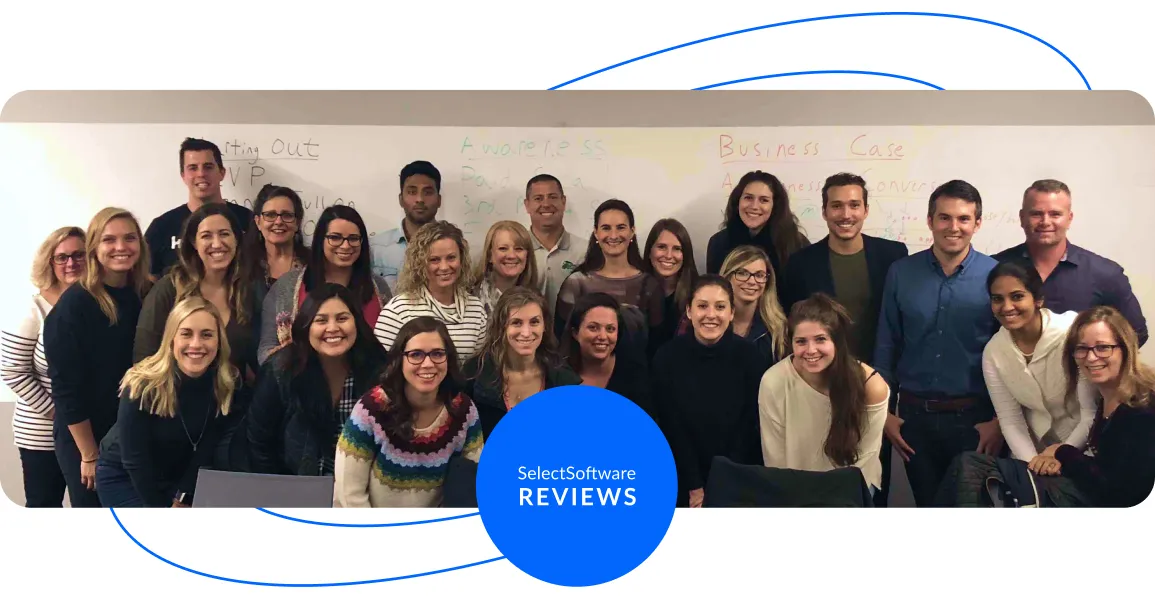
- Our goal at SSR is to help HR and recruiting teams to find and buy the right software for their needs.
- Our site is free to use as some vendors will pay us for web traffic.
- SSR lists all companies we feel are top vendors - not just those who pay us - in our comprehensive directories full of the advice needed to make the right purchase decision for your HR team.













